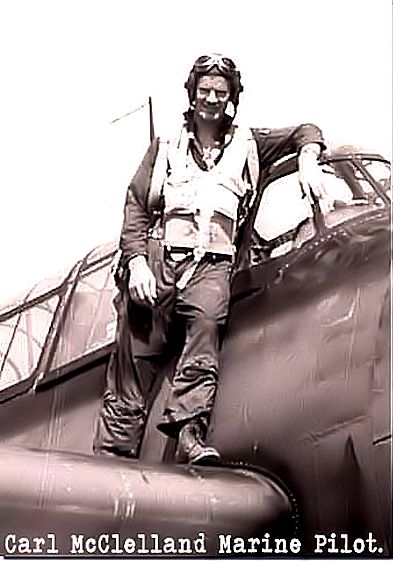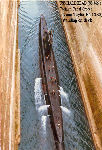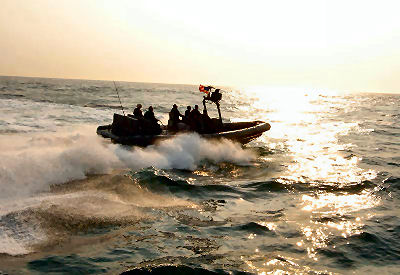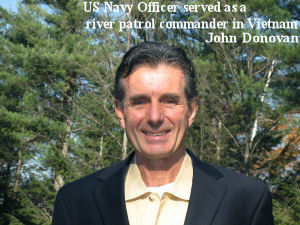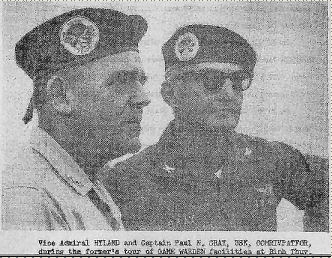BOAT SUPPORT UNIT'S
SEAL ‘Nam Boat Support (BSU-1) Men and theirToys AND also
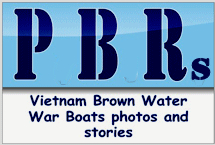

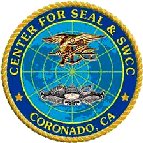
S.W.C.C. please send me photos Doc Riojas docrio45 @ gmail.com
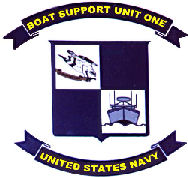
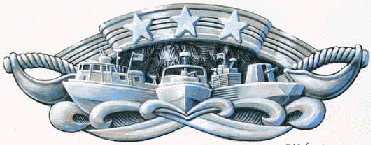
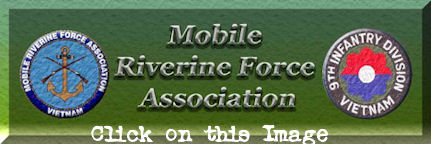
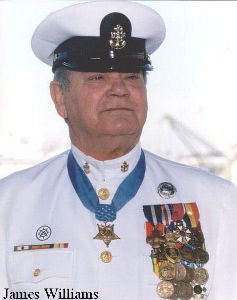
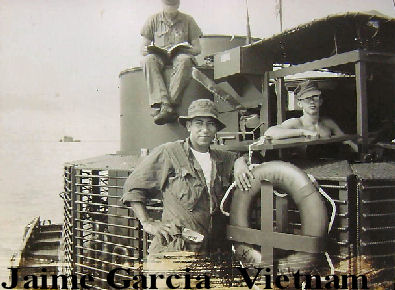
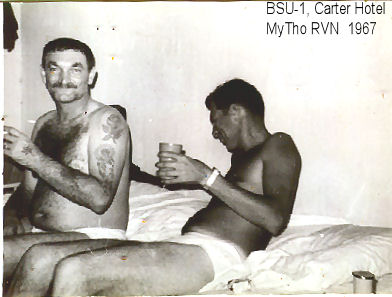
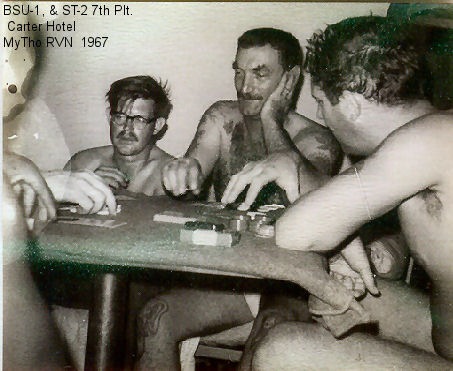
From: Ken Delfino
To: Doc Riojas
Cc: Watson, Steve ; Albert Ocanas
Sent: Friday, June 06, 2008
Subject: Photos of SEAL Boat Suppor Personnel and their Toys.jpg
This is the photo…guy with glasses, doesn’t that look like Bob Leavitt? Pretty darn close if not. That’s what I left out. I know a lot guys played regardless of unit.
Still looks like EN3 Bob Leavitt, engineer on PBR 152 while at Nha Be and My Tho.
Ken
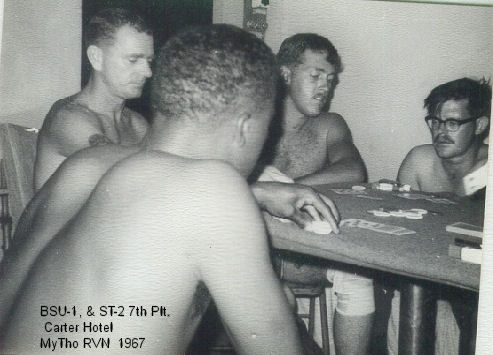
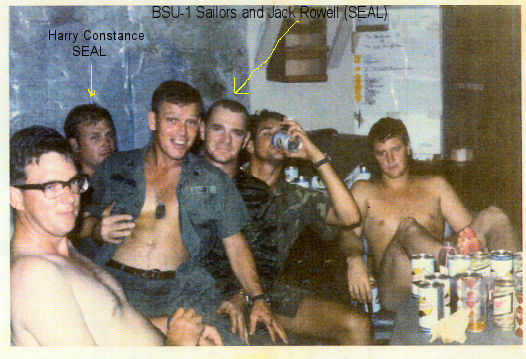
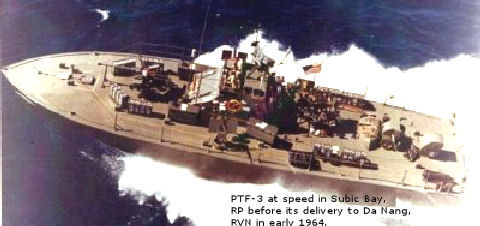
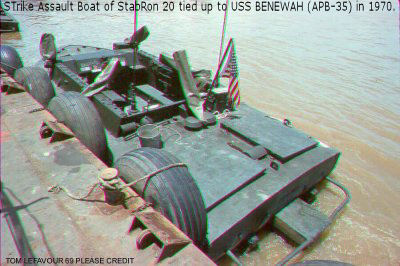
I think it is worth noting that the original boat had the 427 engine with 12 inch water jets. In late fall of 69 Grafton made some changes to the boat Primarily changing to a Mercruser Engine with outdrives.
I went to work for Grafton immediately after discharge in July of 69 I went to California for several months while the new series were being delivered, Always wondered whether they made it to nam.
We applaud what you are doing there is a lot of history here that warrants being documented and told. It was a part of the war few know much about.
Charles Rick Shepherd email: ichasethesun [at] yahoo.com
USN EN3 1965/1969
BSU1 MST 2/3 67/69
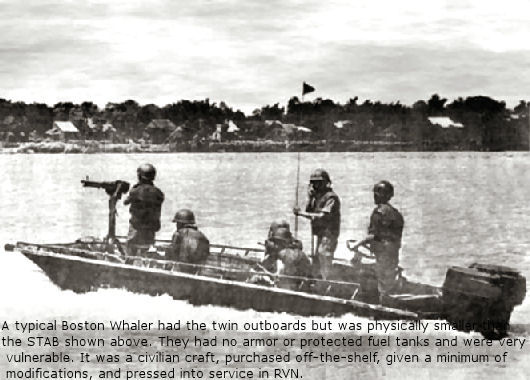
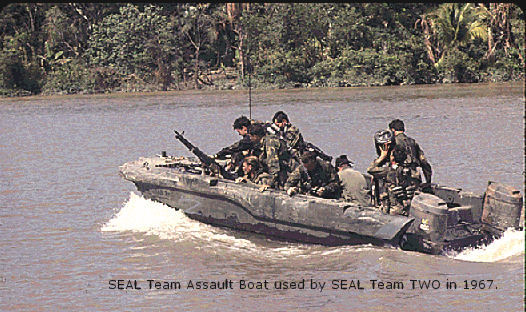
At SEAL Team TWO we call ed the STAB (SEAL Tactical Assault Boat) SEAL Team Assault Boat? Maybe?!
July 15 2006 Santa Fe TX home of Lowell. He is recouperating from Lung surgery. We talked about the times in MyTho ‘nam war games. Good ole days.
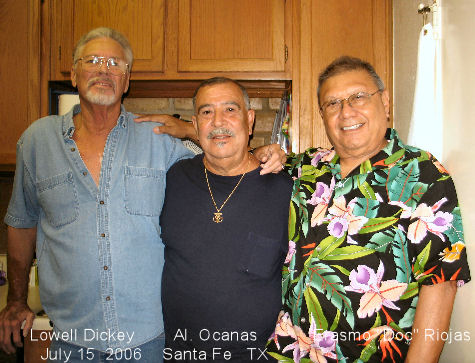
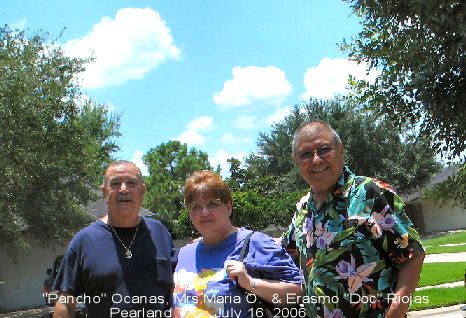
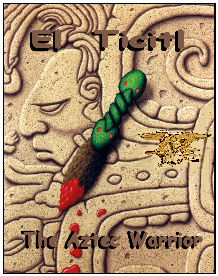

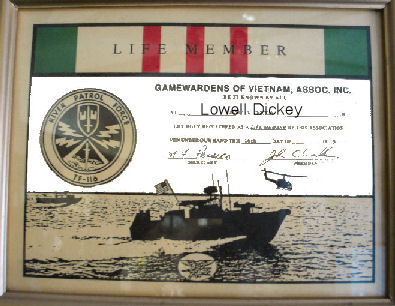
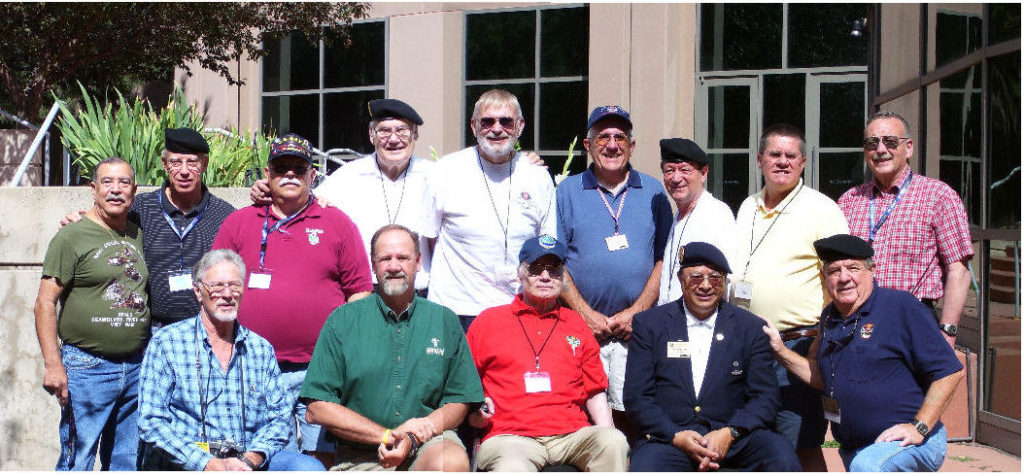
2006 Gamewardens Reunion in Denver: Front Row (L-R): Lowell Dickey, Glen Slay, Bill Goldman, Ken Delfino, Walt Fanton Back Row (L-R): Al Ocanas, Bill Wood, Gary Bay, Jerry Sapp, Dave Ajax, Steve Watson, Harlan McPherson, Duane Pulliam, Jon Inskeep. labeled by Ken Delfino.
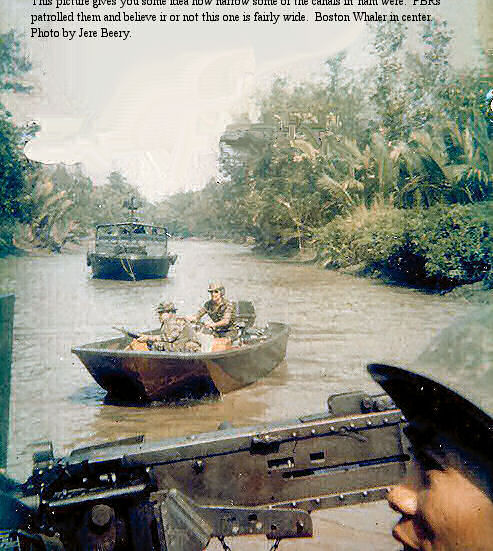
The U.S. Navy SEAL S.T.A.B. Boat; What we remember about them now in 2005
What has Erasmo “Doc” Riojas created here? Please join the discussions. email: docrio @ ev1.net
from: Bob Stoner May 28, 2008
to:Doc Riojas;
Glad you mentioned the STABs. Here’s a short progression on them. As you know, ST-2 developed the first STAB (SEAL Team Assault Boat) for use in RVN in 1967. (I have a connection to the son of the original owner — the boat was a modification of one of their fiberglass boats, PowerCat 23C — and were built for the USN.) ST-2 modified them before using them in RVN. As you indicated, they lost one when it fell from the transport chopper and landed in a parking lot, killing some cars.) John Woody, who was the MST-2 OIC,
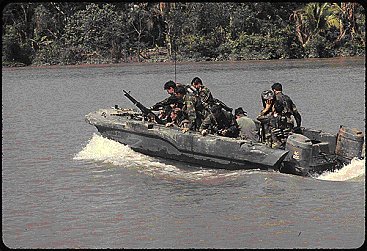
Grafton Boat Works, Grafton, IL built the 16 Light SEAL Support Craft to replace the Boston Whalers, LCPLs, and STABs in-use. The contract was let in 1967, and the boats were delivered in 1968. One boat was retained in Coronado for training and the others went to RVN
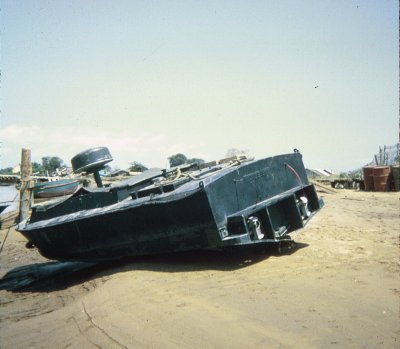
Above: Detchment ECHO’s LSSC on the beach at Nam Can showing off its propulsion system. SEA FLOAT was not built at this time. Admiral Zumwalt and his staff came up with the idea of transporting an LSSC sized boat by helicopter behind enemy lines to raise hell and then get airlifted out. Proof of concept was accomplished by flying an LSSC on a CH-47A Army Chinook helo. The first two lifts went OK. On the third lift, the LSSC developed an uncontrolled oscillation below the helo and it was jettisoned into a rice paddy. The boat hit the paddy and the two engines kept on going. Later that day the Air Force put in an air strike to destroy the remains.
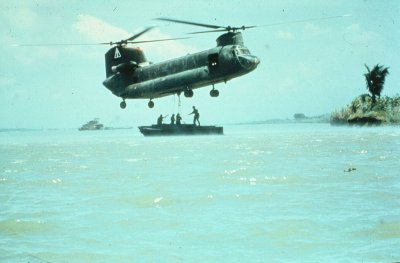
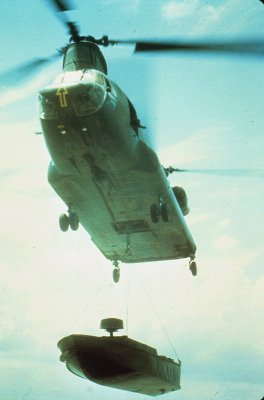
Above: Getting ready to lift the LSSC. Below: The LSSC is airborne carried by an Army CH-47A. The Navy cut a follow-on contract to Grafton for 22 Mk 2 LSSC’s. These boats changed the propulsion from two Ford 427 gas engines and Jacuzzi water jet pumps to two Chevrolet 427 gas engines and MerCruiser stern drives (same as used by the larger MSSC). The Mk 2 boat was designated as the STAB (STrike Assault Boat). The “improved” STAB was two feet longer (26 feet) than the LSSC (24 feet).
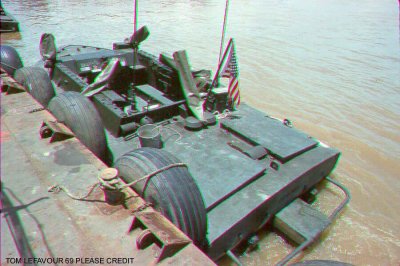
Above: Twenty-two of Grafton’s “improved” LSSC were contracted in 1968 and delivered in 1969. Twenty boats were deployed to RVN as part of StabRon 20. StabRon 20 was under the operational control of RivPatFlot FIVE and not MST-2. Note the differences in the stern and propulsion between the STAB and LSSC. Below: The STAB plaque from StabRon 20 clearly shows the protruding stern drives. During tests at Coronado, the boat ran over a waterlogged piling that ripped one of the stern drives out of the back of the hull.
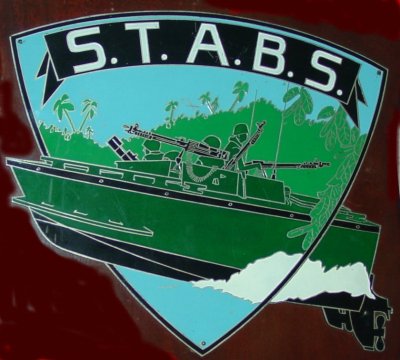
Robert Stoner Photos of Vietnam
Doc Riojas, Monday, June 02, 2008
I just got a phone call from Jim Thomas (BSU/MST — alumni) and he was having problems with getting through to our e-mail address. (The messages bounced back.) I told him that I was getting through OK, and I agreed to send this test message to you with a copy to him.
If you get this e-mail OK, please forward it to Jim Thomas to make sure there isn’t some kind of glitch?
By the way, if you haven’t done so, please to to the www.warboats.org site and lookup the MST section. The MST section has a complete rouster of MSTs/SEALs/UDTs that were in RVN. Please tell your contact list about us, because we are trying to fill-in a lot of blanks with names, dates, and places. NSWG destroyed a lot of historical documents in the late 1980s and early 1990s. The only way to recapture this is to pick the minds of the guys who were there and may have personal records to flesh-out our rouster.
Bob Stoner
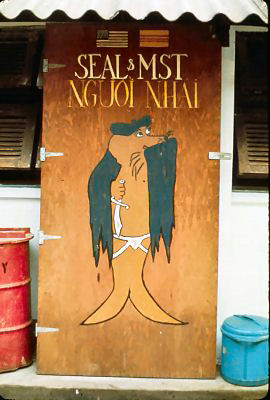
You’re correct about Gary Hunt. MST-2 Det. Alpha, and X-Ray platoon on some. The others I have no clue.
To help with the timeline, go to the MST/SEAL rouster on the Warboats site. This will help a lot. It’s a work in process, but it will stimulate some memories.
Bob
P.S. Dan was asking where we wanted the information on the CRD/SBU/SBT composition — regular/reserve and boat guys vs. SEAL mix. I’ll defer to your judgment on this one. —– Original Message —– From: James and Cheryl GRAY To: Robert Stoner Sent: Sunday, June 01, 2008 11:20 PM Subject: RE: Photos
Bob and Doc, your going to have to give me accouple days to find my notes. Just looking at them. Most of them are X-ray Plt and the MST-2 det that was attached to them was DET ALPHA. If I remember correctly taken by MST-2 member Gary Hunt.
Photo # 7 Is “Happy”Baker photo # 10 is Jim “Half Ass”McCarthy (becuase he got part of his butt blown awayriding a LSSC when ambushed) Doc. you should have a X-ray Plt Roster and Dates and A.O. But I’ll try to find my notes when I was writting a book about MST that nobody wanted to Publish about 10yrs ago. Best Regards, Jim G.
From: rstonercrd21 [at] msn.com To: docrio45 l[at]gmail.com CC: jgrayptf24 [at] msn.com Subject: Photos Date: Sun, 1 Jun 2008
Doc, Jim Gray has more background information on the photos I sent to you. I don’t have that information immediately available to me here. I will forward to him a copy of the photos, and he can fill in the details that he has. What we typically do not know is where the photos were taken, approximately when they were taken, and who the folks are in the photos. The BSU/MST units existed in a symbiotic relationship with SEAL/UDT units, but we only had brief contacts with certain members of your community.
Jim, I sent Doc about 19 photos of SEALs in action from that batch of slides that I copied and digitized. You gave me the additional information on some of them, but certain of the details are hazy with me now and I don’t have my list immediately available. If you could annotate the first 19 photos as best you can, I think that Doc has enough connections with the community to get names for the folks shown in them. I will forward the original message I sent to Doc.
Doc, once you get Jim’s notes, see if your guys can identify the folks in the pictures based Jim’s info. Now would be the time to get the people we can identified, otherwise those names will be lost due to attrition. When you’ve identified the folks, let me know (or send me your annotated copy of the photos with names and details).
Bob
From: Robert Stoner To: Doc Riojas Cc: Jim Gray Sent: Sunday, June 01, 2008 Subject: Re: Photos
Doc, I noted on your site that you are looking for photos of the “guys” in their working days, so I’ll forward some that I have from my collection. Many of them were gotten from our historical preservationist at NAB Coronado, who scoured the dumpsters and trash cans when a lot of this stuff was being pitched out in the 1980’s as of no importance. Master Chief Jim Gray (ret) can give you the details on these photos and I’ve copied him too.
1. Location ?
2. LSSC with SEALs on board. One is CPO Herb Ruth. (Photo was very dark, so I brightened it as best I could.) Can you identify when and where this was taken? People in photo?
3. LSSCs with X-Ray platoon ST-1. Need to ID people.
4. ST-1 members aboard HSSC. I think SEAL on far left is SMC Tommy Hachett (sp?).
5. Test fire of M72 LAW from HSSC. Anybody recognize themselves?
6. Visiting Aussie SAS trooper operating with ST at first photo location. Anyone know him?
7. One ST member “gone native”. Anyone know who, when, where?
8. SEAL with detainees. Name, when, where?
9. SEALs and LDNN is Thuy. Names, when, where?
10. SEAL with “Pig” (M60). Name, when, where?
11. X-Ray platoon ST-1 and LDNNs. Names, when, where?
13. Location? 14. SEAL radioman. Name, when, where?
15. SEALs and LDNN on sampan op. Names, when, where?
16. LDNN — Name, when, where?
l7. SEALs debarking from Huey. Names, when, where?
18. PO3 Birkey (front, ST-1) doing sampan search about two weeks before he was killed. Name, when, where?
19. RADM Tom “Hulk” Richards at 2004 Seawolf Reunion.
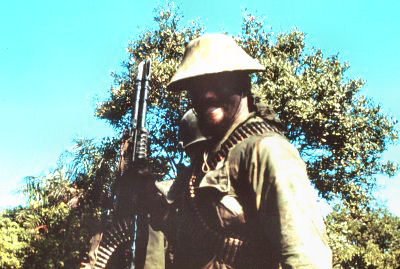
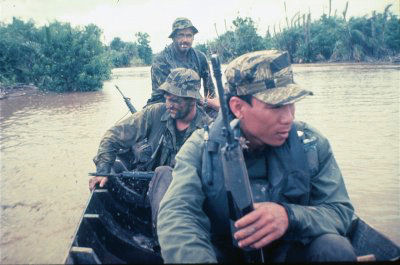
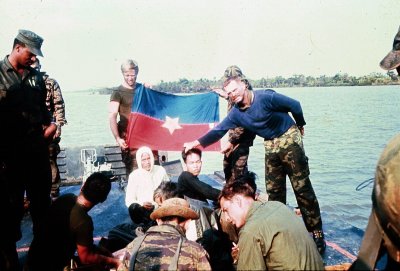
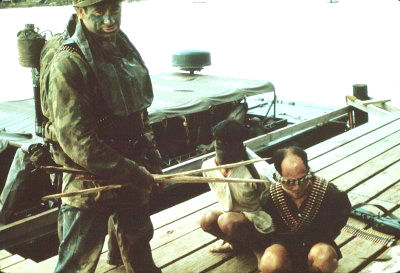
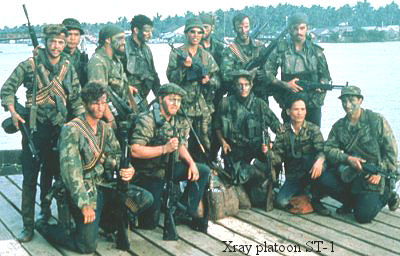
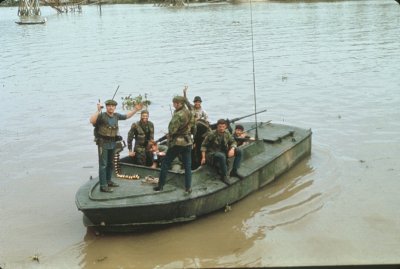
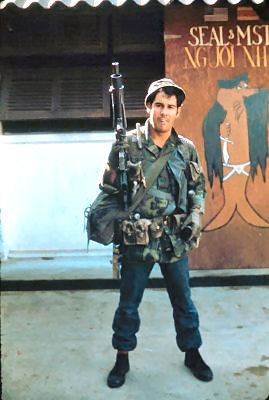
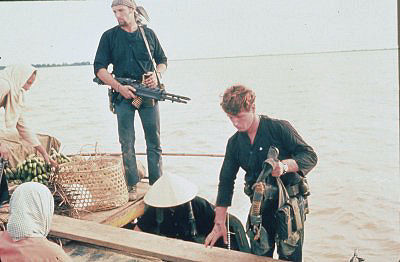
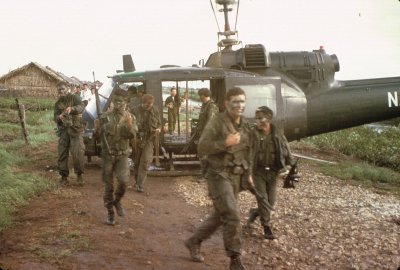
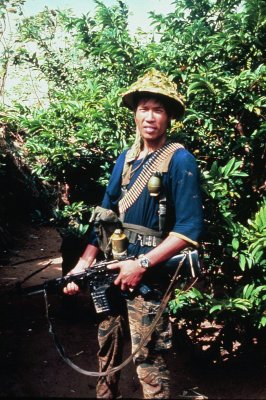
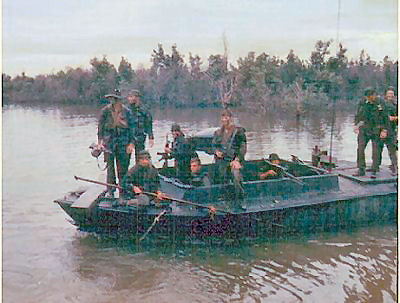
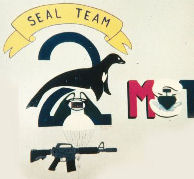
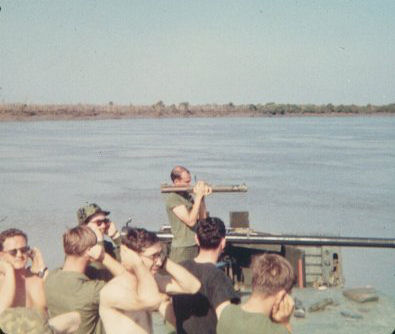
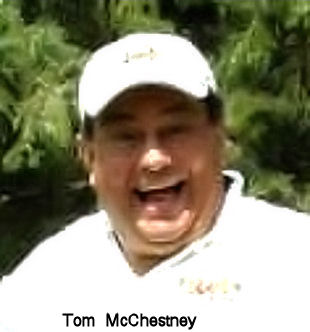
Subj: TOM McChesney BSU 1 dies agent orange exposure
From:bsu1mst2 [at] comcast DOT net
To: Doc Rio45 [at] gmail DOT com ;
jim &doc
it is with a heavy heart that i send this email jim i know he was your boat officer down in ca mau i had to take little mo down to seafloat with det charlie work with the other coast but TOM McChesney was one cool officer agreat friend and one of the rare Os that walked over the quaterdeck at BSU1 and a boatguysdream to work with GODS speed and TILL WE COME ALONGSIDE AGAIN rest in peace strong email to follow abt bsu1 50 yrs in commission with the new SWCC sw working on assoc now CCCA REUNION OCT1_4OCT 2014 QMC TOMMY LEPRECHUAN MOFFATT( SW AW DV SWCC)
From: “Jim Marsh”
To: bsu1mst2 [at] comcast DOT net
Sent: Saturday, August 24, 2013 1:04:52 PM
Subject: BSU 1 dies agent orange exposure
Tom McChesney, LTjg BSU 1 69-72 deployed Song on Doc 1st tour and DaNang 2nd tour died few weeks ago of complications from leukemia (bone marrow transplant was unsuccessful) caused by agent orange exposure in country.
Obit in Green Bay Press Gazette. His wife apparently confused SEAL team with BOAT Team.
Tom McChesney Obituary More Photos View all 4 photos McChesney, TomTom McChesney, age 68, currently of Green Bay, went home to his mother on July 17, 2013 after a brave and valiant fight with leukemia, never having lost hope, thanks to the help of many wonderful caregivers. He was born March 4, 1945 in Cornell, WI to the late Lauren and Alice (Lund) McChesney. He attended UW-LaCrosse and Kansas State University before serving his country as a Navy SEAL. – See more at: http://www.legacy.com/obituaries/greenbaypressgazette/obituary.aspx?n=tom-mcchesney&pid=
165916713&fhid=14017#fbLoggedOut
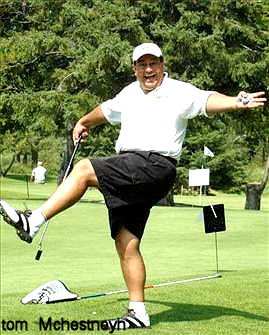
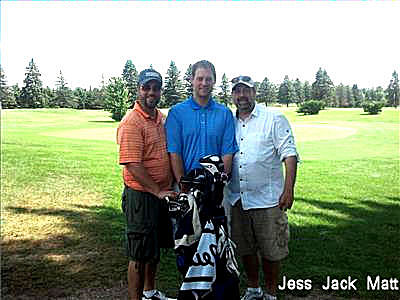
I also suffer with leukemia and recently had a bone marrow transplant about the same time as Tom to fight the disease. My doctor is pleased with my recovery and I take it a day at a time
If you haven’t had a blood test recently schedule one with your doctor and look for any signs of a blood disorder. There is a list of diseases on VA website associated with agent orange, leukemia, diabetes type2, Parkinson’s, and others. Veterans and their spouses may be entitled for disability compensation
Hope this message finds you well
Best
Jim Marsh OINC Det D Nha Be 1970 OINC Det Subic. 1971
4651 Dallas TX 75209
Rio
I found the photo in SEALTWO BSU Zero
Scroll down from top of page approx 20%
By the way I see photos of Doug Bateman. At one time a good friend. Give him my regards
to: Doug, Jim ,Erasmo “Doc” Riojas A.K.A. : Doc Rio
Doug Bateman,
Jim Marsh says Hello, email me please.
this Photo submitted by Jim Marsh.
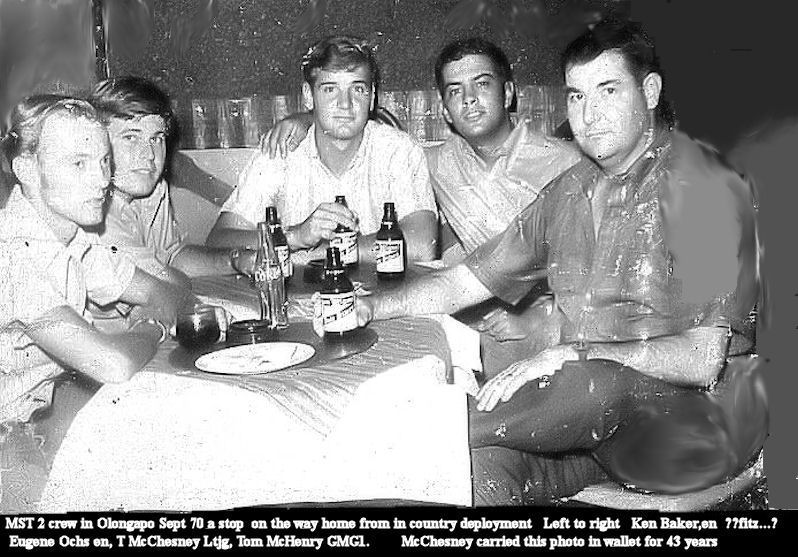

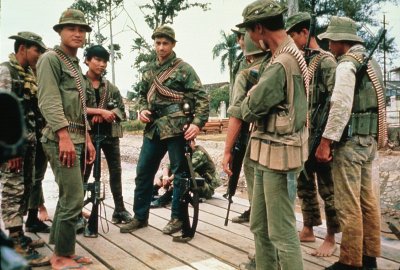
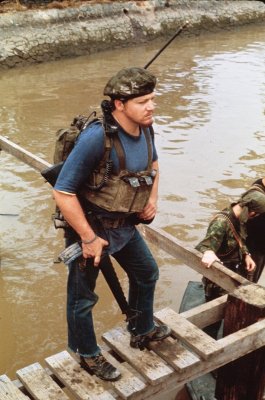
—– Original Message —–
MY NOTE: Somebody help this poor guy ! Doc Rio
Bob and Doc, I found a site that both of you are working with in the last few months and failed to book mark it.Please send it to me, I knew Doc Hill and Joe Churchill. Thanks Jim Thomas —– Original Message —– From: “Robert Stoner” <rstonercrd21 [at] msn.com> To: <danwithers [at] qwest.net>; <jamethomas [at] homexpressway.net> Sent: Sunday, March 19, 2006 Subject: RE: BSU/MST – Jim Gray input to list
Outstanding input from Jim Gray. I wish we could do a “core memory dump” into a computer somewhere. He’s a walking encyclopedia.
From: “Dan Withers” <danwithers [at] qwest.net> To: “‘James S Thomas'” <jamethomas [at] homexpressway.net>, “‘Robert Stoner'” <RStonerCRD21 [at] msn.com> Subject: BSU/MST – Jim Gray input to list Date: Sun, 19 Mar 2006
—–Original Message—– From: James and Cheryl GRAY [mailto:jgrayptf24 [at] msn.com] Sent: Sunday, March 19, 2006To: dwithers [at] rodaxwireless.com Subject: RE: BSU/MST/etal: Service Units
From: “Dan Withers” <dwithers [at] rodaxwireless.com> To: “‘James S Thomas'” <jamethomas [at] homexpressway.net>,”‘Robert Stoner'” <RStonerCRD21 [at] msn.com>,<jgrayptf24 [at] msn.com> Subject: BSU/MST/etal: Service Units Date: Sat, 18 Mar 2006
Dan, Here’s my imput on the list below I just made changes on Your list below. Need any thing else please ask. I checked out you ships page , looks good. I think the PTFWeb site should remain same as is. War boats should expand. MST-2 DETS can go to both sites really as they were part of BSU-1 your call on that guys. On the matter of the SEAL names, and I love my brother frogmen, and I have allot of friends are SEALs. they have their on websites and full blown association.They don’t include us in their platoon listings. My say is unless the SEAL served under and part of the Boat Units (ie. many SEALs serve in SBUs and SBTs now.) It was my belief that we hope to bring all the Boatguys together and grow into a assc. like the SEALs. In Seperate areas. and I would have no problem with a associate
section. added where we can put SEALs, VNN PTFers, and Friends Like Chip marshal and other contributers. Dan I am Prepared to send you SBU-13 Info. Cheers, Jim G.
===========================================================================
=
BSU-1 MST Dets
MST-1 Da Nang
—————————————
MST-2 Det Alpha – Ben Thuy Det Alpha – Ben Tre Hotel Platoon, SEAL Team One S-Ray Platoon, SEAL Team One Det Alpha – Ben Luc Mike Platoon, SEAL Team One Det Bravo – Ben Luc/Nam Can (SeaFloat) Bravo Platoon, SEAL Team One Det Charlie – Nam Can (Solid Anchor) Echo Platoon, SEAL Team One Foxtrot Platoon, SEAL Team One Golf Platoon, SEAL Team One Whiskey Platoon, SEAL Team One Zulu Platoon, SEAL Team One
2nd Squad, SEAL TEam One – Dan Doi LDNN Advisor UDT-12, Det Golf Det Delta – Nha Be
7th Platoon, SEAL Team Two Det Echo – Rach Soi Kilo Platoon – SEAL Team One Romeo Platoon – SEAL Team One LDNN Advisor Det Foxtrot – Ca Mau
9th Platoon, SEAL Team Two Yankee Platoon, SEAL Team One – Bach Lieu Det Golf – Nam Can (SeaFloat)/ Long Phu Juliet Platoon, SEAL Team One Kilo Platoon, SEAL Team One Mike Platoon, SEAL Team One Victor Platoon, SEAL Team One LDNN Advisors Det ? – Ben Thuy/Nha Be Det Charlie – Song Ong Doc/Sea Float
3rd Platoon, SEAL Team Two UDT-12, UDT-13, UDT11
————————————-
MST-3 – Nha Be Det Echo – Nam Can (Sea Float)
————————————-
Coastal River Squadron One – 1971 CRD-11, CRD-12, CRD-13 Moble Support Team 3 Subic bay
————————————-
Special Boat Squadron ONE – 1978 Cornado Special Boat Unit ELEVEN – Mare Island NRF Special Boat Unit Twelve – Coronado Special Boat Unit Thirteen Coronado NRF Special Boat Dets, Subic, Guam, Bahrain, Args etc.
————————————-
BSU-2 Little Creek.
————————————-
Coastal River Squadron Two – 1972
————————————-
Coastal River Squadron Two -Little Creek CRD-20 Little Creek Coastal River Division – Twenty One – Great Lakes NRF Coastal River Division – twenty Two – New Orleans NRF
————————————-
Special Boat Squadron Two 1978 Little Creek Special Boat Unit 20 Little Creek Special Boat Unit 22 New Orleans NRF /Steniss Ms Special Boat Unit 24 Little Creek NRF Special Boat Unit 26 1983 Panama Special Boat DETs ( east coast boys can fill these in)
______________________
Naval Special Warfare Group-4 2002 Little Creek Va. (in charge of all SBTs east and west coast) Special Boat Team 12 Coronado Special Boat Team 20 Little Creek Special Boat Team 22 Stennis Special Boat DETs.
=========================================================================
Doc and John, This is what I got back from Fred Schuler. Does this stimulate any memories? Bob —– Original Message —– From: Fred Schuler To: Robert Stoner Sent: Friday, September 23, 2005
Subject: Re: STABs
I did The driver is Jim Bunning I think BM2. I don’t know the other guy.

Monday, September 19, 2005
To: Doc Rio
Cc: John Woody
Re: hey bob where is the URL that I asked you for My understanding is that the Boston Whaler company made three of these STABs for RVN service. They were not built on the standard Boston Whaler hull because it was too narrow for moving people fore and aft on the boat efficiently. Boston Whaler Co. used a different hull configuration that had interior armor, self-sealing fuel bladders, and a low profile for the operator (who was on the centerline). These first STAB’s were interim designs until the Grafton-built LSSC came in-country. I think John Woody (now president of Gamewardens of Vietnam) told me that he brought three of the boats over along with six of their special 115 hp silenced outboard engines. He wasn’t clear as to whether he was counting the outboards as the ones installed on the boats or if the six were additional spares for those already on the boats. Once the LSSC was in-country, these fiberglass STAB’s (well-worn from combat operations) were discarded. [John, did I recall this correctly, or am I thinking of someone else who brought these first STAB’s and the engines over to RVN?] Bob
SEAL Team Assault Boat (bow-on).
STAB A typical Boston Whaler had the twin outboards but was physically smaller than the STAB shown above. They had no armor or protected fuel tanks and were very vulnerable. It was a civilian craft, purchased off-the-shelf, given a minimum of modifications, and pressed into service in RVN. Doc Riojas IZE: 10pt; COLOR: black; FONT-FAMILY: Arial”>To: Robert Stoner HT: Monday, September 19, 2005 2:17 PM Re: hey bob where is the URL that I asked you for If you take a look at the photo of the STAB you sent me, you will see that it is not the hull of a boston whaler.le=”FONT-SIZE: 10pt; COLOR: black; F It is much longer, and men cannot walk back and forth on a boston whaler, too small and it would capsize it. correct me if I am wrong. Original Message —- Robert Stoner grgrinage [at] yahoo.com Glen Grinage and grgrinage [at] yahoo.com grgrinage@yahoo.comDoc Rio Monday, September 19, 2005 STABs (SEAL Team Assault Boat) as I knew it Hi Glen (and Doc),
Did Doc forward the photos of the STABs to you? What did you think of them? If he didn’t let me know and I will forward what I have. As I understand it, the first STAB (SEAL Team Assault Boat) was a Boston Whaler-built hull with two 115 hp silenced outboards. Three of them were brought over with SEAL Team TWO in the 1967 time period. They were eventually replaced by the Light SEAL Support Craft (LSSC). The second STAB (STrike Assault Boat) was the brainchild of VADM Elmo R. Zumwalt, COMNAVFORV. He envisioned the airlift of an LSSC-sized craft behind enemy lines, heavily armored and armed, to raise hell with the VC/NVA and then be extracted. Proof of concept was done using an LSSC. There were three helo-lifts done by an Army CH-47 “Chinook”. The first two were successful; the third resulted in an uncontrolled oscillation beneath the helo. The LSSC was cut away and landed in a rice paddy. The two Ford 427 engines kept going into the muck. The USAF was called in to bomb 10pt; COLOR: black; In 1969, Grafton Boats, the same builders of the LSSC, built 22 Mk 2 LSSC’s (aka STAB) for the Navy. These boats were 2 feet longer than the Mk 1 LSSC and had twin Chevy 427 engines with MerCruiser stern drives instead of the Ford 427s and water pumps. Two boats were left stateside for training and 20 boats were sent to RVN in January 1970 under command of LCDR Kirk Ferguson. The unit was called StabRon 20 and operated on the upper Mekon River . There normal patrol area was the 40 miles of the Grand Canal between the Mekong and Vam Co Tay River. Ten boats of StabRon 20 were part of the Cambodian invasion in May 1970. They were withdrawn from Doc Riojas, R: black;
The Sea Float/Solid anchor Word file was posted to the www.mst2-vietnam.info site. The one that I sent you is the latest revision that has the stuff on Song Ong Doc added. I don’t think Dan Withers — he maintains the website — has picked it up yet, so you might want to use the latest, revised version. Verdana”>I’ve been supporting the websites of others, so “technically” I don’t own one of my own. However, I “feel” like I own it, because of the writing I’ve done for them. I keep thrashing about and writing. I am doing a series of articles about the PTF’s for the MRFA newsletter “River Currents.” Oy, such a deal I have for you on STAB boats.
I have your SEAL Team Assault Boat and your Strike Assault Boat. Both are on the www.warboats.org site. Verdana”>The PTF stuff is on the www.ptfnasty.com site. Verdana”>Oh, yes. Please take a look at the MST/SEAL/UDT rosters on the www.mst2-vietnam.info site. We could use a lot of help filling in blanks of people attached to the various detachments and platoons, especially in the early years of the Vietnam conflict.
Robert Stoner GMGC, BSU-1 with ST-1 ‘nam war games.
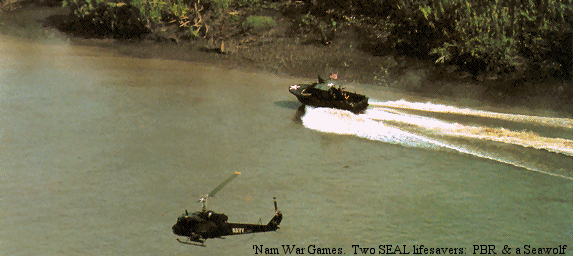
Hi Glen Grinage and Doc Rio,
Did Doc forward the photos of the STABs to you? What did you think of them? If he didn’t let me know and I will forward what I have. As I understand it, the first STAB (SEAL Team Assault Boat) was a Boston Whaler-built hull with two 115 hp silenced outboards.
Three of them were brought over with SEAL Team TWO in the 1967 time period. They were eventually replaced by the Light SEAL Support Craft (LSSC). Verdana”>The second STAB (STrike Assault Boat) was the brainchild of VADM Elmo R. Zumwalt, COMNAVFORV. He envisioned the airlift of an LSSC-sized craft behind enemy lines, heavily armored and armed, to raise hell with the VC/NVA and then be extracted.
Proof of concept was done using an LSSC. There were three helo-lifts done by an Army CH-47 “Chinook”. The first two were successful; the third resulted in an uncontrolled oscillation beneath the helo. The LSSC was cut away and landed in a rice paddy. The two Ford 427 engines kept going into the muck. The USAF was called in to bomb the remains. black; FONT-FAMILY: Verdana”>In 1969, Grafton Boats, the same builders of the LSSC, built 22 Mk 2 LSSC’s (aka STAB) for the Navy. These boats were 2 feet longer than the Mk 1 LSSC and had twin Chevy 427 engines with MerCruiser stern drives instead of the Ford 427s and water pumps.
Two boats were left stateside for training and 20 boats were sent to RVN in January 1970 under command of LCDR Kirk Ferguson. The unit was called StabRon 20 and operated on the upper Mekong River . There normal patrol area was the 40 miles of the Grand Canal between the Mekong and Vam Co Tay River.
Ten boats of StabRon 20 were part of the Cambodian invasion in May 1970. They were withdrawn from Cambodia by July 1970 and the unit was split into two divisions. One division of StabRon 20 went to Nha Be and the other to Dong Tam. They operated out of these bases until they were ordered to stand down and go home at the end of October 1970.
Bob Stoner
Greetings, Doc.
The BSU-1 crowd became either MST-1 (HQ Da Nang — PTF support) or MST-2 (HQ Binh Thuy — SEAL/UDT boat support) when deployed. Operationally, they were part of TF-116 Gamewardens. I know John Woody, an ex-BSU-1/MST-2 guy who’s president of the association, Gamewardens of Vietnam (GWVN).
I wear two hats — I was with TF-117 on the first tour (Mobile Riverine Force) off Dong Tam and with MST-2 (TF-116) at Nam Can (SEAFLOAT/SOLID ANCHOR) on the second tour. I’m a member of both MRFA and GWVN. The Gamewardens site is www.tf116.org. All the contact information is on the site, including John Woody’s e-mail.
Robert Stoner MCPO (ret)
From: Robert Stoner [mailto:RStonerCRD21 [at] msn.com]
Monday, September 19, 2005 3:35 PM
To: Doc Rio docrio45 [at] gmail.com
John Woody
Subject: Re: hey bob where is the URL that I asked you for My understanding is that the Boston Whaler company made three of these STABs for RVN service. They were not built on the standard Boston Whaler hull because it was too narrow for moving people fore and aft on the boat efficiently.
Boston Whaler Co. used a different hull configuration that had interior armor, self-sealing fuel bladders, and a low profile for the operator (who was on the centerline). These first STAB’s were interim designs until the Grafton-built LSSC came in-country. I think John Woody (now president of Gamewardens of Vietnam) told me that he brought three of the boats over along with six of their special 115 hp silenced outboard engines.
He wasn’t clear as to whether he was counting the outboards as the ones installed on the boats or if the six were additional spares for those already on the boats. Once the LSSC was in-country, these fiberglass STAB’s (well-worn from combat operations) were discarded. <fon[john, did=”” i=”” recall=”” this=”” correctly,=”” or=”” am=”” thinking=”” of=”” someone=”” else=”” who=”” brought=”” these first=”” stab’s=”” and=”” the=”” engines=”” over=”” to=”” rvn?]=””></fon[john,>
Bob
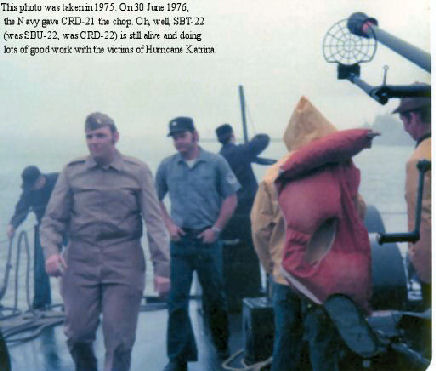
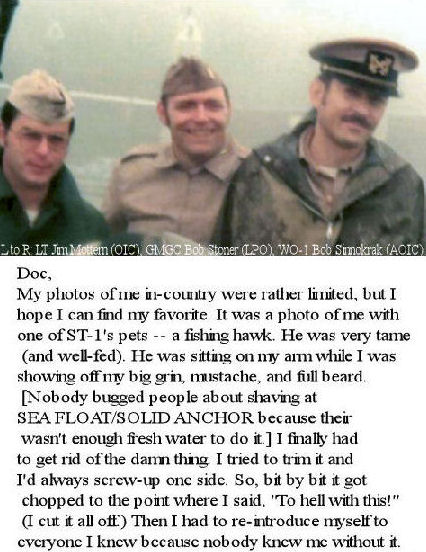
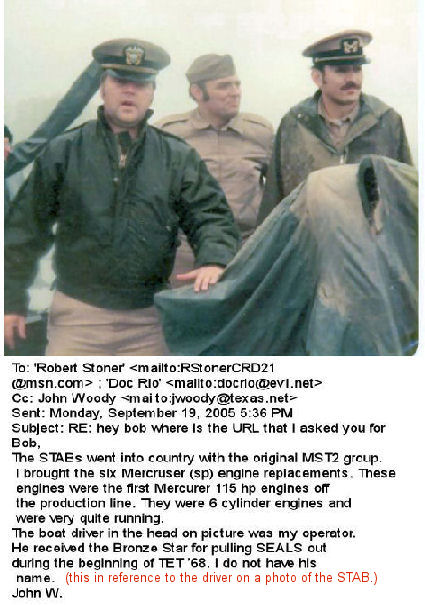
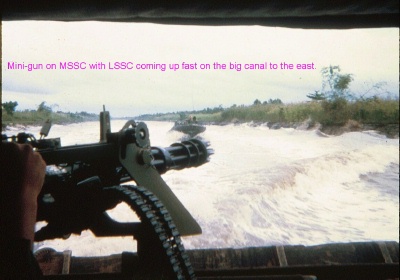
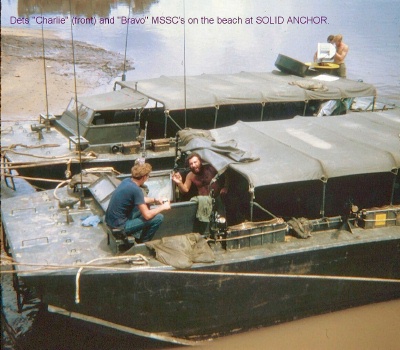
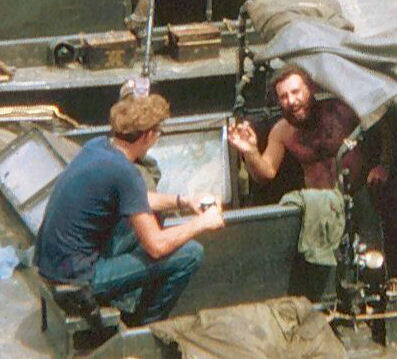
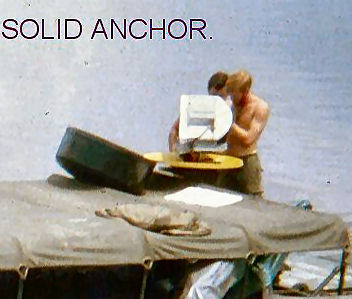
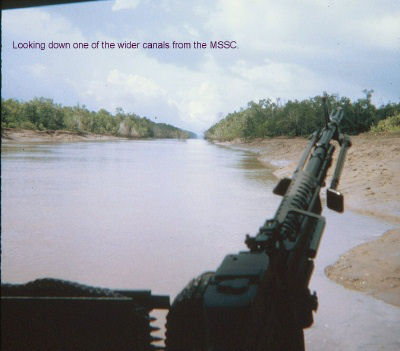
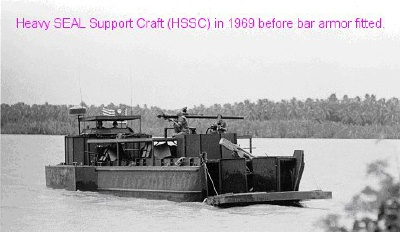
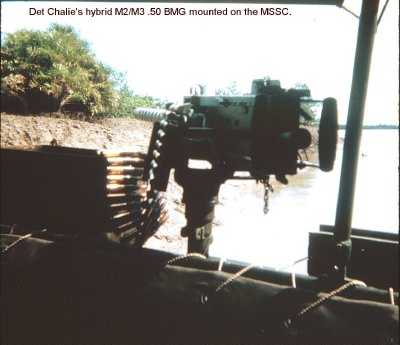
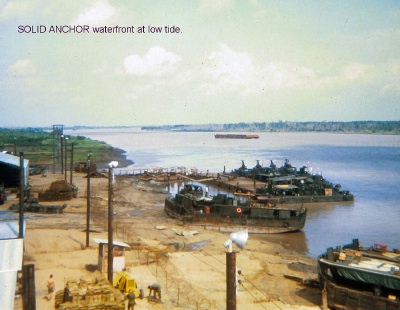
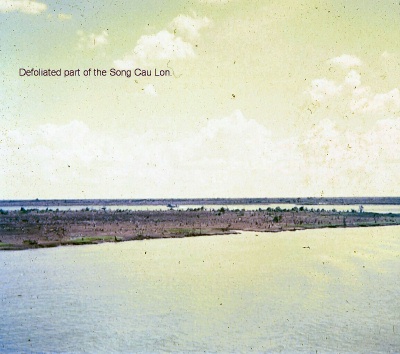
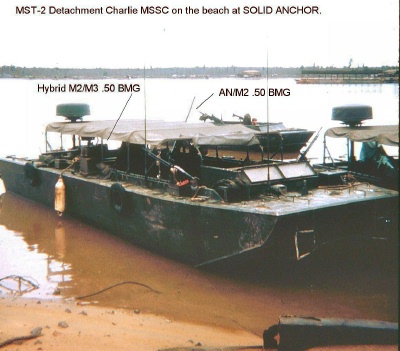
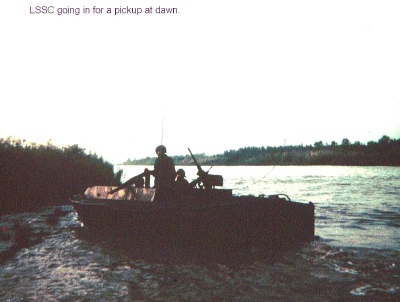
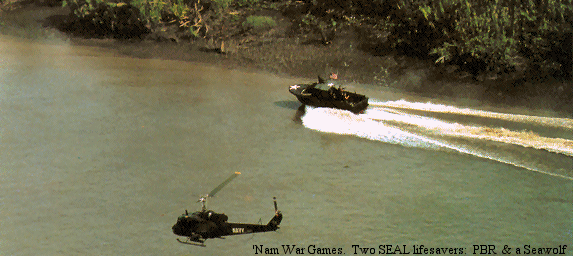
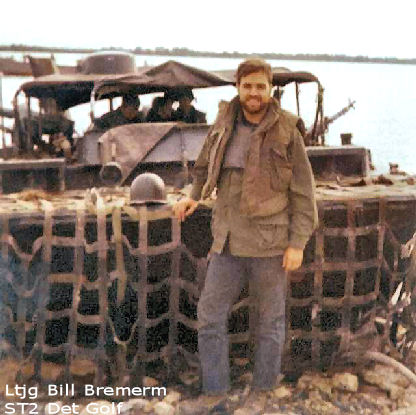
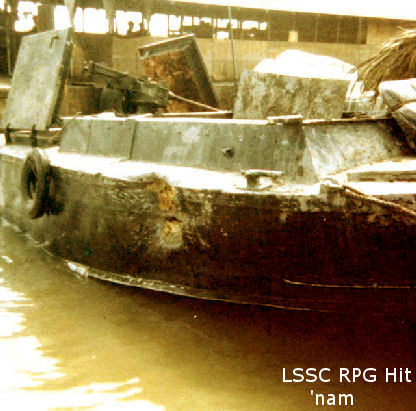
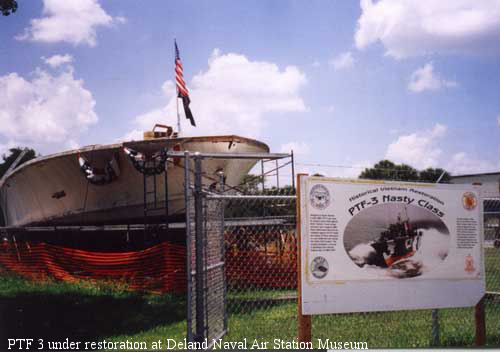
—– Original Message —–
From: Norman Olson To: Doc Rio Cc: Robert Stoner
Sent: Wednesday, September 21, 2005
Subject: Re: creating a page for SEAL Boat Support men and toys
LT Jack “Blackjack” Macione of SEAL Team TWO designed, fabricated and outfitted the STAB (SEAL Tactical Assault Boat). I believe there were only two, not three. Unfortunatly, he’s dead and the history went to the grave with him.
Norm
Riojas’ note: while transporting one of those STABs with a helicopter, it was twirling a lot and broke lose lot at Desert Cove, Little Creek VA. I remember the story told saying that it landed on one of the guys auto. He called his insurance agency and told them that a boat had landed on top of his car and they would not believe him. I was not at the Team at the time of this memorable event.
I wish somebody could’ve taken a photo of that, maybe they did, Archie Grayson was our photographer, maybe he has a photo of that event. I’ll give him a phone call after RITA blows over.
From: John Woody Thursday, September 22, 2005
To: All,
I always thought there were three STABS; we called them Trimarine (sp). I started my OIC tour at My Tho with our LCM. Capt Price TF116 called me to Bien Thuy to as OIC to be close to TF116. I traded places with one of my Det Officers. We were keeping the LCM in My Tho so that the SEAL dets would have its availability and TF 116 would not be able to use it for independent ops as much as they did when it was on the Bassac.
There was a STAB at My Tho and at Bien Thuy. I carried two 7.62 mm miniguns with me as I deployed in addition to the Mercursers engines. The SEAL Det at Bien Thuy was lead by Marcinko and Jake Rhinebolt.
I was the third OIC of MST2. There was a MST3 over in the area of Saigon. Capt Price ordered me to take control of that MST as overall OIC and make it a Det within MST2. I sent an msg to BSU One stating that unless otherwise directed, I had assumed command of MST3.
We mounted one of the miniguns on the LCM in My Tho and the other on my LCPL.
It was during this time that the SEAL Dets were beginning to feel the strain of using the LCPLs. They did not mind the firepower we carried, but the transit times were long, especially going home. I conducted about 45 missions with Marcinko and about 15 missions independently. This was during and just after TET 68.
We did move the LCM to Bien Thuy for the trip to Roc Jaw (sp) on the Thailand Gulf. We did this through a canal from the Bassac to the coast. This was the first trip by any Allied military on this canal during the war. It was here that we (SEALs) unset the balance of the U Min forest area.
We returned the LCM to My Tho after this mission. It was placed in overhaul at the Ninth Inf. Facility there.
My first tour in Vietnam was with MST1 in Da Nang. I was the PTF training officer doing missions and training of the Vietnamese boat crews.
On return to CONUS after the MST2 tour, I was Ops Officer and XO of BSU One.
There were three STABS.
John Woody
To:El Gordo: Friday, September 23, 2005
From: Hoot Andrews
During the outfitting of SEAL Team TWO, I ordered 2 catamaran’s from commercial sources. They had two 100 HP Evinrudes for each. The Guys mounted a recoiless 3.5 rocket launcher in each. The could carry a 2-thousand pound payload. We trained with them down in St. Thomas each year. Just thought you ought to know. that was in 1962. Resp. HOOT
—– Original Message —– From: Striperseal [at] aol.com To: trident33 [at] comcast.net ; docrio45 [at] gmail.com
Sent: Saturday, October 01, 2005 5:03 PM
Subject: Re: Fw: Boats in Vietnam
NORM,
I cant be sure but i believe only two.
WILLIAMS was operating one when he got shot in the back+paralized from the waist down. I will always remember visiting him in the VN. HOSPITAL. HE WAS A REAL SUPER SEAL AND PERSON..I WILL NEVER FORGET HIM.
I think the stabs were only used on the 1st trip ,and then replaced by our new boat built at Grafton Ill.
I rember one stab that I know didnt go = the one I watched fall on the autos in the desert cove parking lot. Watching that almost made me sick.good to hear from you
Jake Rhinebolt
—– Original Message Larry Bailey Erasmo Riojas ; Jake Rhinebolt Sent: Sunday, October 02, 2005 Subject: Re: The fate of one of our STABs at Little Creek Razzmo: I can tell you everything you want to know about the first STABs, as Jack “Black Jack” Macione, Bob “Eagle”Gallagher, and I were in charge of developing and modifying the off-the-shelf catamarans bought by Hoot Andrews. I have to say that I had very little input in how the STABs turned out, as Jack and Bob were the idea guys. I just hung around and took the credit! 🙂 Jack and Bob really did all the work. We would come up with an idea and run over the the Navy Yard at Portsmouth and have the idea incorporated into the boat.
Jake Rhinebolt’s account of the dropping of the first STAB in the Desert Cove parking lot in Dec. 1966 is accurate. I was home on leave when Bill Garnett called me and told me about it. We were sling-testing it for an Army sling lab at Ft. Lee or Ft. Eustis (as I remember), and the pelican hook straightened out. The sling was fine, though! The account of the sailor telling his insurance company what happened is the truth. Garnett told me that the STAB absolutely totalled the car, and the STAB was a total ruin, of course.
As I recall it, a replacement STAB was put together and sent to Vietnam at a later date. I’m not sure. I do remember that Det A in Can Tho/Binh Thuy had the survivor during my tour in 1967. It was not a BSU-1 asset at that time, but it became one (maybe during that tour); I remember that Ron Fox, Ken Estok, and Pierre Birtz were coxswains.
I think the Boston Whalers that originally were at Can Tho went with the Mike Boat to My Tho. The armored LCPL and the STAB remained with Third Platoon at Can Tho. So says my fading memory…
BTW, did you guys know that Ron Fox’s son, John, is coach of the Carolina Panthers?
Larry Bailey Actually, you can find various versions of “STAB” almost from Day One. Macione, Gallagher, and I called it one thing, but it became another and another. I don’t know if it HAD any “official” name. Maybe the official history of ST-2 during those days would settle the dispute.
Larry Bailey
PS: It was not a SEAL T.A. Craft, as somebody mentioned.
That would make it “STAC!” Actually, you can find various versions of “STAB” almost from Day One. Macione, Gallagher, and I called it one thing, but it became another and another. I don’t know if it HAD any “official” name. Maybe the official history of ST-2 during those days would settle the dispute. Larry Bailey
—– Original Message —–
From: Dee Clark To: Erasmo Riojas Sent: Tuesday, October 04, 2005
Subject: Original STAB
Rio,
As I remember it, The original STAB was a fiberglass TRICAT 23 foot triple hull catamaran. Jack Macione who had previously worked with fiberglass car bodies showed Melochik and Brozak how to mount the center mount 50 cal tripod on valve lifter springs to absorb recoil, which worked well.
The center mount could support the 5.56 MM mini-gun. He also designed the side mounts for 57MM recoilless rifles, 3 per side,which were fired by the coxswain via foot pedal and aimed by turning the boat. There were 4 M60 mounts, one on each quarter I don’t know that the mini-gun was ever used, but I saw the Honeywell M18 40MM grenade launcher, hand cranked model, mounted there in summer of 1967.
I was a PRU adviser in Sadec province when LT. Rick Trani and his platoon paid me a visit before he bought the farm. They used that configuration with some success.
The boat was powered by two 100 horse Mercury outboards at that time.
Sorry, no pic’s.
A.D. Clark ST-2 Plank owner
John Woody [mailto:jwoody [at] texas.net]
bold”>Sent: Monday, October 03, 2005
To: ‘Robert Stoner’; ‘Ty Zellers’; ‘Tom Hawkins’; ‘Norm Olson’; ‘Barry Freece’; ‘Bill Moreo’; ‘Bob Rieve’; ‘Carl Chitwood’; ‘Doc Rio’; ‘Don Tyson’; ‘Steve Thomas’; broberts [at] brandywine.net; ‘Charles Bayer’; fgs [at] charter.net; ‘Randy Miller’
John Woody
RE: MST-2/SEALs — Rosters !
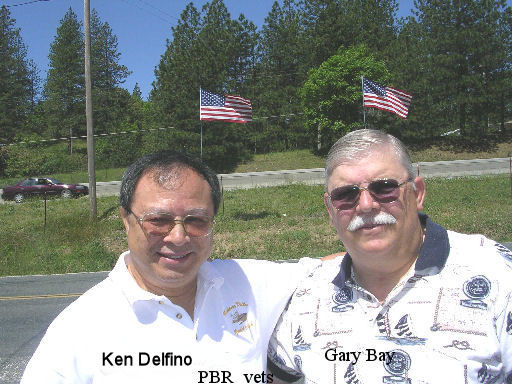
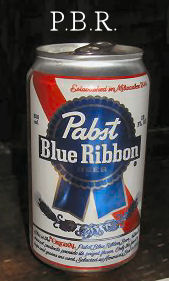
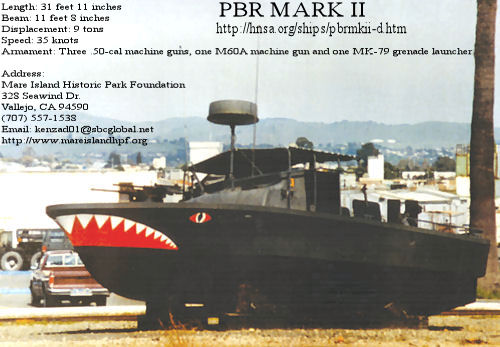
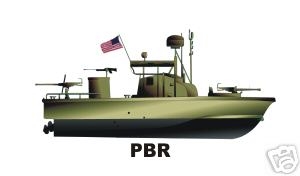
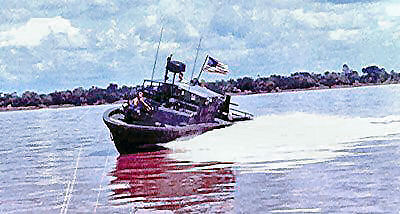
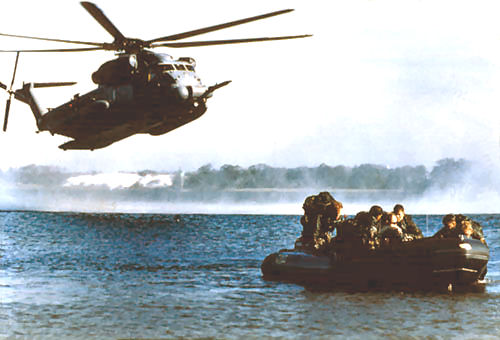
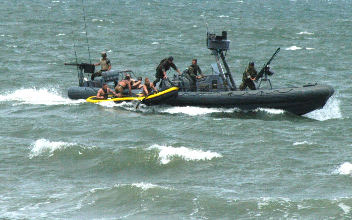
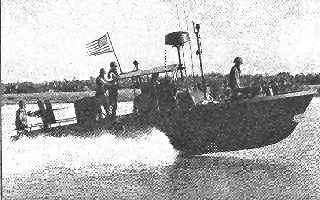
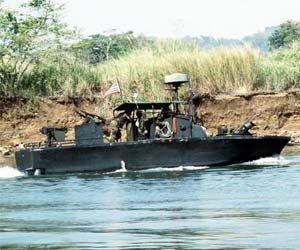
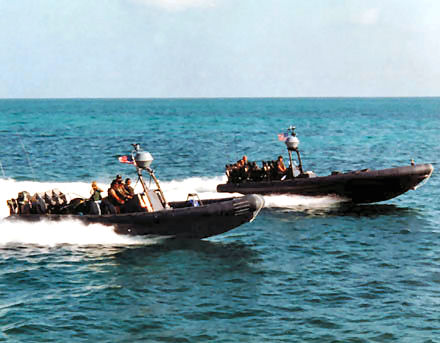

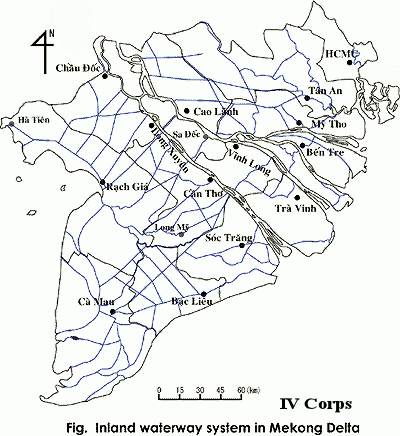
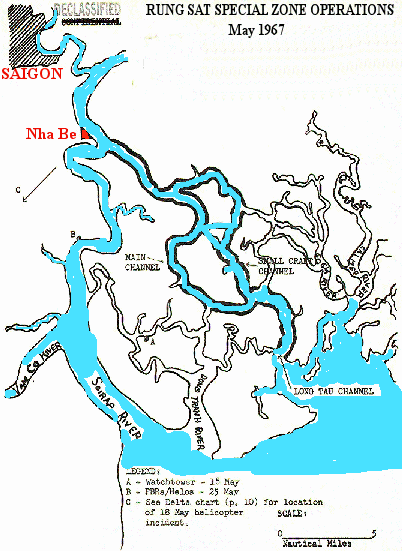
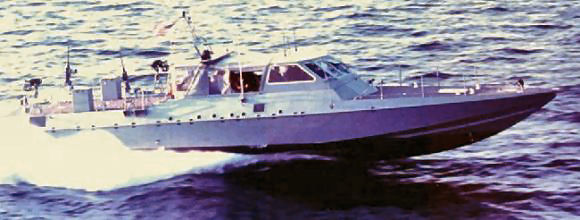
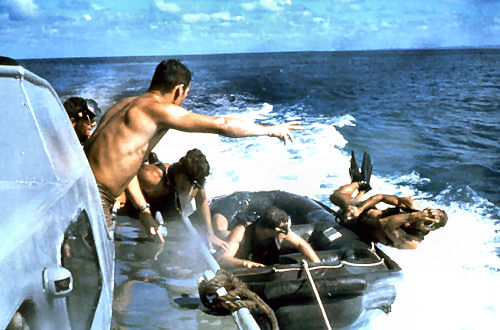
Doc,
Great web site, I forwarded it to several Vietnam Vets, mostly Swift Boat riders and PBR hands. I served with, shipmate, friend, EOCS Olin Nelson USN SEAL, early 80s, Special Boat Unit 22 NOLA, and Operation Kindle Liberty, Panama, then lost track of him in the mid 80s.
I was Patrol Officer, boat line maint. Chief at the time. Somewhere I have some photos of he and I during Panama ops. PBRs and Mini ATCs. Pearl River, Miss. Ops too.
Once during a dull Saturday night at the NSA Chief Club NOLA, Senior Chief was sitting at the bar when a Marine and a base Chief got into it, a bit of a fist fight,
Nellie broke it up by grabbing both by the collar,, introduced himself as NELSON “Easter SEAL” , ” This is my FUCKIN Chiefs Club, if ya want to fight here, you ask me FIRST”
We all cracked up except for the jarhead, he stomped out and did not show his face for a while.
Doug Traylor ENC USNR ret.
Plankowner US Dept. Homeland Security Retired Lake Somerville TEXAS
No problem. Say Doc, on another note, I’m wondering if my patrols ever took you (personally) out on ops. Here’s where I was and when:
RivDiv 533 entire time 10/66-11/66 – Cat Lo 12/66-5/67 – Nha Be 5/67-7/68 – My Tho, Jennings County, Garrett County, Hunterdon County Tet ’68 – in MyTho 26Jul1968
– luck ran out in Ben Tre Canal on PRU mission pick-up
My patrol officers on these missions were QMC Frank Jackson, RD1 Wilbur Cosson (KIA 7/7/67 lower Ham Luong) and LTjg Frank Yusi
My patrols did a lot of delivery and pick-ups with your teams.
Ken Delfino
—– Original Message —– From: Erasmo Riojas To: Ken & Melba Delfino Sent: Monday, June 12, 2006 8:23 AM Subject: Re: Here ya go
Oh man….we were there TOGETHER! Our crew (PBR152) was on the bottom floor…I think the 2nd room from the corner.
Anyway, I was there that morning…groggy from a very good celebration with the PHILCAG detachment and couldn’t really wake up during that attack. My crew threw two mattresses between my rack an the outer wall and took off. I got up a few minutes later and ended up riding shotgun for the crew shuttle driver. I didn’t pull river patrols that first week…Rich Wies, Dennis Keefe and Garza joined me when we went out and pulled the ‘off-duty’ PHILCAG team from their villa out at the “Y”. You might remember that all of a sudden we had a bunch of Filipino military personnel at the Carter and in officer’s country. A lot of them knew my family in Manila (I’m American-born) because they were in the entertainment business. I had a lot of great home-cooked Filipino dishes during my tour!
With Pops, we were providing a blocking force for an ARVN operation on the lower Ham Luong in the Long Toan Secret Zone. We were operating off the beach with our guns trained down a straight and wide creek. The ARVN were pushing them toward that spot where we’d just pick off all sampans and/or swimmers. We had laid down a lot of suppressing fire for the ARVN and later in the day I was not only running low on ammo (forward tub), but my barrels were becoming worn. Rounds were going out and going wherever they wanted so rather than risk having a round hit our cover boat, I just loaded my forward tub with blooker ammo and all the small arms.
Two boats were coming toward us with resupply and new barrels and to save time, we turned to meet them. While we were closing range, the rear gunner spotted movement starting to cross the creek so Pops called PBR 160 alongside and he shifted to that boat. They turned and went back into the fray…rather than waste time transferring stuff, we told the two boats to follow and get in the fray while we took up the rear. When 160 closed in to about 20 yards off the beach, with LT Moir’s boats about 30 years behind them, they took heavy fire and Pops took a round in his head just under his lid. 160 boat did an immediate 180 heading for the “T” while the other two boats relieved us. He was still alive when we got him on the Dustoff, but died before he arrived at Dong Tam. He was a damn good patrol officer….and a friend.
I ended up meeting his family in Salt Lake City during a Kiwanis convention in 1995. The next year our convention was in Nashville and I realized that the Florida panhandle was not that far away. I drove down to DeFuniak Springs and met his mom and spent July 4th with them. I commuted from Suisun City to Fisherman’s Wharf for about 16 years and on July 7th every year, I’d stop off at Treasure Island and lay a wreath in the lobby of Cosson Hall.
I know you guys kept to yourselves a lot, but Pops, Chief Jackson, Frank Yusi and Dick Strandberg knew your guys pretty well…we pulled a LOT of ops with your teams. We may very well have run across each other in the mess hall…or one of the bars or restaurants downtown if not together on ops.
Anyways, are you going to the Gamewarden reunion in Denver this August? If not, how far are you from San Antonio? Our Kiwanis International convention will take place in San Antonio next year and maybe we can hook up with some other Gamewardens.
Ken Delfino
—– Original Message —–
From: Robert Stoner
To: jwoody@texas.net ; ‘William Bremer’ ; ‘Tom Hawkins’ ; ‘Roger Clapp’ ; ‘Randy Miller’ ; ‘Norm Olson’ ; ‘Mick Fulkerson’ ; ‘Kerry L. Ruth’ ; ‘Jim Gray’ ; ‘james s. thomas’ ; ‘Erasmo “Doc” Riojos’ ; ‘Don Tyson’ ; ‘Dan Withers’ ; ‘Bob Rieve’ ; ‘Steve Thomas’ Sent: Saturday, February 10, 2007 8:23 AM
Subject: Re: Heavy SEAL Support Craft
Thanks for the updates and clarifications, John. Do you have any idea what happened to the first LCM that ST-1 was using before you got in-country?
As I understand it, the first boat took the direct hit with a mortar round that messed-up a bunch of people, but it seems to have dropped off the radar with the arrival of your purpose-designed and built craft. It could be that the damage on the ST-1 improvised boat was so bad that it had to be surveyed.
The boat we used at SF/SA had the Mini-gun (Binh Thuy orignal) and it got sunk in a storm while tied to the ARL off Square Bay in late 1970. Whatever details on the Nha Be boat will have to be filled-in by those who operated there.
Bob Stoner
—– Original Message —–
From: John Woody
To: ‘Robert Stoner’ ; ‘William Bremer’ ; ‘Tom Hawkins’ ; ‘Roger Clapp’ ; ‘Randy Miller’ ; ‘Norm Olson’ ; ‘Mick Fulkerson’ ; ‘Kerry L. Ruth’ ; ‘Jim Gray’ ; ‘james s. thomas’ ; ‘Erasmo “Doc” Riojas’ ; ‘Don Tyson’ ; ‘Dan Withers’ ; ‘Bob Rieve’ ; ‘Steve Thomas’ Sent: Friday, February 09, 2007 9:51 PM
Subject: RE: Heavy SEAL Support Craft
Bob,
MST 2 brought the Binh Thuy boat. The MST 3 boat was the Mighty Mo as far as I can remember. This was as far as I can remember being the third OIC of MST 2. We moved the Binh Thuy boat to Me Tho to keep it from being used by Capt Gray who was using our craft for his initial canal incursions. MST 3 was at Nha Be.
We had a LCPL at Binh Thuy when I was there.
John W.
All,
I just received some photos as part of a story from Ron Allen who was with MST-2, Det. Alpha, at Nha Be. It has photos of the Nha Be boat that is quite different in layout from the photo I got from Don Crawford that shows the Binh Thuy boat. Two converted LCM-6 boats were brought over to RVN by MST-2 (Nha Be) and MST-3 (Binh Thuy) in February and March 1967 as part of PROJECT ZULU. These boats are quite different from the SEAL Team ONE converted LCM-6 called the “Mighty Mo” of 1966.
Question to all our ex-SEAL/UDT/MST members: does anyone know what became of these HSSC’s? The Binh Thuy boat eventually went to SEA FLOAT/SOLID ANCHOR. It was lost in a storm at the end of 1970 when it was tied up to the ARL off Square Bay on the Gulf of Thailand side of RVN. The storm punched one or more bar armor supports through the side of the hull. The boat flooded and sank. No records appear to have survived about these craft — that is, whether they were scrapped or given over to the South Vietnamese Navy as part of AcToV.
Bob
to All;
Here’s what I’ve gotten so far.
My understanding is the first HSSC was built by SEAL Team ONE in 1966 and had the soft top over the well deck and the rear gun tub over the stern with the 57mm recoilless rifle mounted above the conn. I have not found out what happened to it. It may have been scrapped in-country.
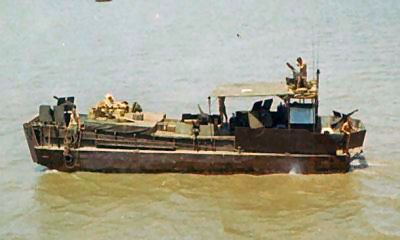
Project ZULU brought the two modified PacFlt LCM-6’s over. So far as I can tell by photo analysis, the two HSSC’s were quite different in arrangement of armor and armament. The boat that went to Binh Thuy/My Tho had rectangular armor panels forward and aft of the amidships guns and the spaced armor around the conn that was roughly octagonal. The conn did not have a cover over it at first, but the well deck had a fabric cover.
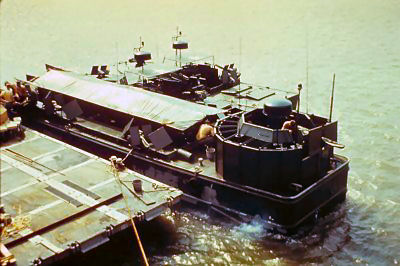
Right and Left: Note the upgrades in the second photo: the helo pad (no gun tub or recoilless) and spaced armor around the engine room.
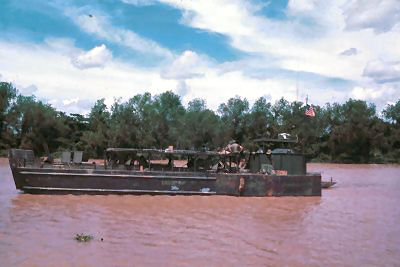
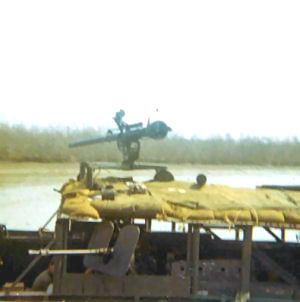
The well deck was soon covered over. First by a plate with sandbags and later beefed up to hold a chopper. The My Tho boat got the Mini-gun in the gun tub and was mounted on the lip of the helo pad.
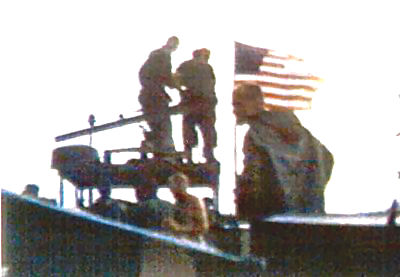
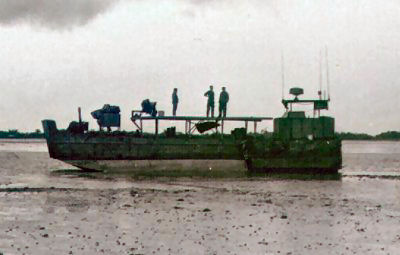
Above: Next to final version of My Tho boat with gun tub and recoilless, but no bar armor. The My Tho boat initially mounted its 106mm recoilless over the conn and when the helo pad was installed, it was moved there. The My Tho boat mounted its 106mm recoilless behind the Mini-gun tub.
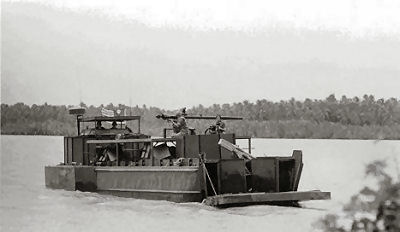
The boat at Nha Be had a different arrangement of the side mounted armament and the spaced armor around the conn was much larger and more box-shaped.
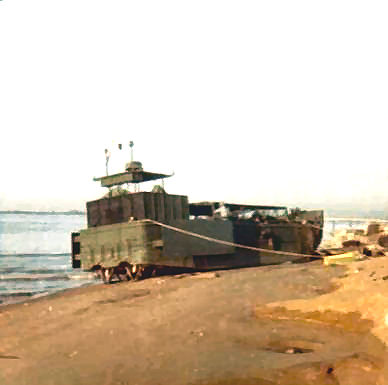
Above: The Nha Be boat had a box-shaped conn and spaced armor around the engine room. Note forward mounted 106mm recoilless and no gun tub in this photo.
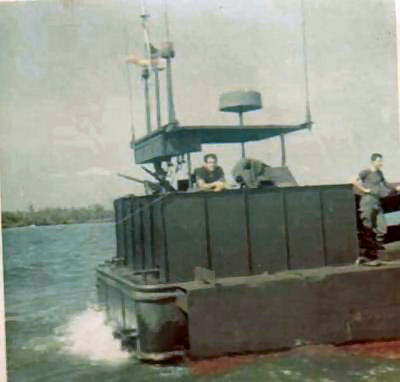
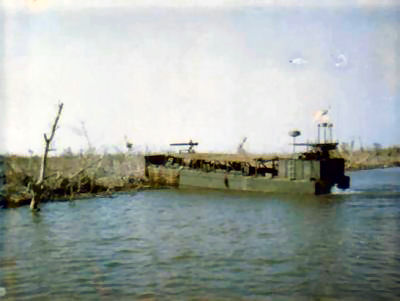
Above and below: The Nha Be boat had a gun tub ahead of the helo pad and mounted a twin .50 set up. Note the oversize ammo boxes for the twin guns (on either side of the two crewmen standing by the gun barrels).
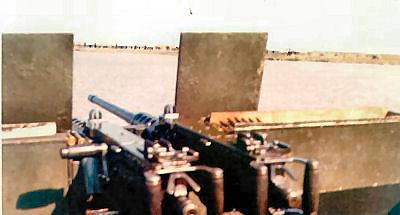

Both boats used the Mk 2 Mod 0 81mm mortar initially. The My Tho boat was upgraded to Mk 2 Mod 1 (w/the .50 BMG) in late 1968 and got bar armor by late 1969. We used this boat at SF/SA in 1970. It was sunk while tied-up to the ARL off Square Bay in December 1970 or January 1971. I have no idea what happened to the Nha Be boat. It may have been turned over to the Viet Navy as part of AcToV.
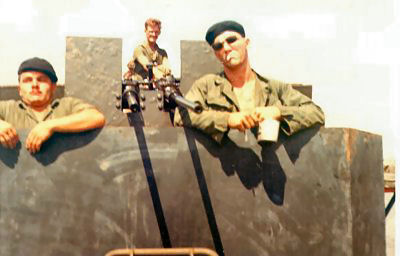
Above is a VNN photo of the HSSC. It could be the Nha Be boat was turned over to them and they replaced the twin .50 with single guns as appears here. The layout is that of the Nha Be boat.
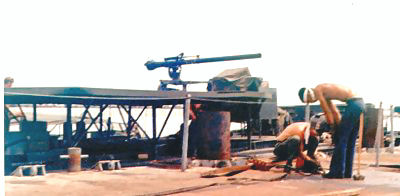
This email was cleaned by emailStripper, available for free from http://www.papercut.biz/emailStripper.htm
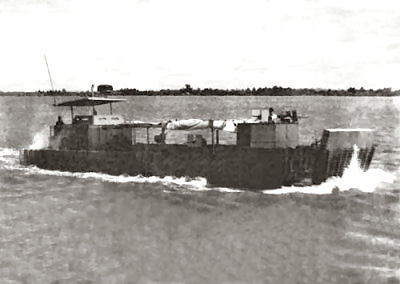
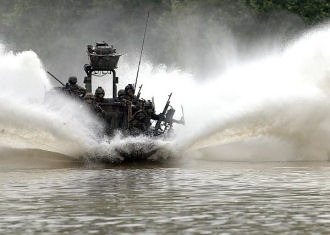
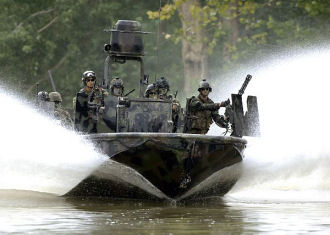
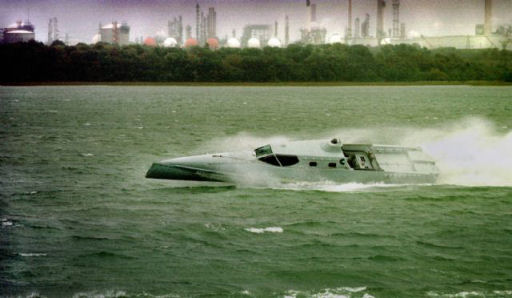
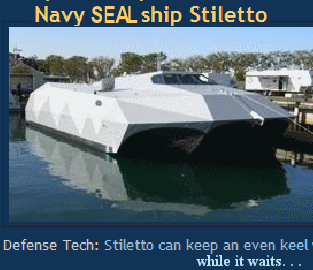
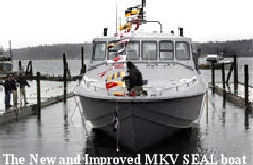
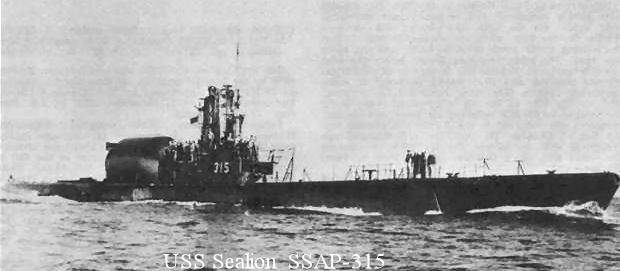
The second Sealion (SS-315)
was laid down on 25 February 1943 by the Electric Boat Co., Groton, Conn.; launched on 31 October 1943; sponsored by Mrs. Emory Land; and commissioned on 8 March 1944, Lt. Comdr. Eli T. Reich in command.
Following the shakedown, Sealion, assigned to Submarine Division (SubDiv) 222, sailed for the Pacificand arrived at Pearl Harbor on 17 May. Furthertraining occupied the next three weeks; and, on 8June, she headed west on her first war patrol. Sailing with Tang (SS-306), she stopped off at Midway on the 12th; glanced off a whale on the 15th; and, on the 22d, transited Tokara Strait to enter the East China Sea. On the 23d, she and Tang took up stations in the Osumi Gunto, an island group to the south of Kyushu. That afternoon, Sealion unsuccessfully conducted her first attack; then underwent her first depth charging.
On the 24th, Tinosa (SS-283) joined the two submarines; and the group moved northward to patrol the approaches to Sasebo. Patrolling in adjacent lanes, the submarines contacted a convoy on the 25th, but Sealion lost depth control on reaching attack position and was unable to fire.
From the Sasebo area, the submarines moved toward the Korean peninsula. On the 28th, Sealion caught and sank a Japanese naval transport, Snasei Maru, in the Tsushima Island area; then continued on into the Korean archipelago. On the 30th, she used her deck guns to sink a sampan; and, with the new month, July, she moved closer to the China coast to patrol the approaches to Shanghai.
On the morning of 6 July, Sealion intercepted a convoy south of the Four Sisters Islands and, at 0447, commenced firing torpedoes at two cargomen in the formation. Within minutes, the 1,922-tpn Setsuzan Maru sank, and the convoy scattered. Sealion retired to the northeast to evade the convoy’s escort, a destroyer,as it began its search for the submarine. At 0600, the destroyer closed Sealion; and the submarine fired four torpedoes at the warship. All missed. An hour later,enemy aircraft joined the search which was continued until mid-afternoon
Three days later, Sealion moved northward again and commenced hunting between the Shantung peninsula and Korea. Dense fog blanketed the area and left her blind while her radar was out of commission. By midnight on the night of 10 and 11 July, however, her radar was back in partial operation; and, on the morning of the 11th, she conducted several attacks, sinkingtwo freighters, Tsukushi Maru No. 2 and Taian Maru No. 2.
The running surface chase with the second freighter involved three attacks over a period of almost seven hours. On the third attack, at 0711, Sealion fired her last torpedo; then, after debris from the explosion had flown over the submarine, she moved down the port quarter of the target, pouring 20mm. shells into the Japanese bridge. At 0714, the freighter disappeared; and Sealion headed south of Tokara Strait. On the 13th, she cleared that strait; and, on the 21st, she arrived at Midway.
Refitted by Fulton (AS-11), Sealion departed for the Bashi Channel and her second war patrol on 17 August. Hunting with Growler (SS-215) and Pampanito (SS-383), she transited the channel and moved into the South China Sea on 30 August. During the pre-dawn hours of the 31st, she conducted a night surface attack against a Japanese convoy and heavily damaged a tanker. As Rikko Maru bellowed black smoke, other Japanese ships took Sealion under fire with deck guns. The submarine moved out of the area and ahead of the convoy. At 0720, she again attacked the convoy. Within minutes, Shirataka, a minelayer, went down; enemy planes begin circling the area; and the convoy’s surface escorts began their search. Sealion went deep and headed south. Later that day, she closed another target with a merchant ship appearance; but, as she reached firing position, the target was made out to be an antisubmarine vessel. Three torpedoes were fired, but were spotted by the target’s bow lookout. The target swerved, and the hunter became the hunted. Depth charging followed without damage to the submarine; but Sealion, low on fuel and torpedoes, headed for Saipan.
There, the submarine rearmed and refueled; and, on 7 September, got underway to rejoin her attack group. On the 10th, she moved through Balintang Channel. On the llth, she rendezvoused with two other submarines; and, on the 12th, the group attacked and decimated a convoy en route to Formosa.
At about 0200, Growler attacked the formation. Pampanito and Sealion followed suit. Growler’s torpedoes sent a destroyer to the bottom. Sealion fired two torpedoes, both misses, and was taken under fire by two of the escorts. The submarine went to top speed and managed to keep ahead of the escorts until they broke off to rejoin the convoy shortly before 0330.
An hour and one-half later, Sealion again closed the convoy and, at 0522, fired three torpedoes at a tanker; then swung to fire on a large transport, Rakuyo Maru, the last ship in the nearer column. At 0524, the tanker Zuiho Maru, possibly hit by torpedoes from both Pampanito and Sealion, burst into flames. Kachidoki Maru, a transport near the tanker, was disabled. She swung into the burning tanker and was soon ablaze. Sealion’s second target was illuminated; and, at 0525, she fired on Rakuyo Maru. Both torpedoes hit and that ship began to burn.
Sealion was then forced deep and, after several attempts to get a better look at the scene, cleared the area and started after the remainder of the convoy.
On the morning of the 15th, the three submarines reformed their scouting line. That afternoon, Pampanito radioed Sealion, and other submarines in the area, to return to the scene of the action on the 12th. Rakuyo Maru had been carrying Australian and British prisoners of war. By 2045, Sealion had taken on 54 POW’s and started back to Saipan. All of the POW’s were coated with crude oil and all were in poor health, suffering from malaria, malnutritional diseases such as pellagra and beriberi, and exposure. Three died before the submarine reached Balintang Channel on the 17th. On the 18th, Case (DD-370) rendezvoused with Sealion and transferred a doctor and a pharmacist’s mate to the submarine. On the 19th, a fourth POW died; and, on the 20th, Sealion arrived in Tanapag Harbor and transferred the surviving 50 to the Army hospital there.
Prom Sainan, Sealion returned to Hawaii. Arriving at Pearl Harbor on 30 September, she departed again on 31 October and, with Kete (SS-369), headed west to patrol in the East China Sea. The two submarines stopped off at Midway on 4 November; then continued on to their patrol area.
Ten days later, Sealion transited Tokara Strait. On the 16th, her number 8 tube was accidentally fired with both doors closed. Heavy seas prevented a thorough inspection of the damage. On the 17th, she began patrolling the approaches to Shanghai. On the 18th, there was a hydrogen explosion in the battery space of the torpedo in number 5 tube. On the 21st, at 0220, she made radar contact with an enemy formation moving through Formosa Strait at about 16 knots and not zig-zagging.
By 0048, the pips were made out to be two cruisers and two battleships. At 0146, three additional ships, escorts-one on either beam of the formation and one on the starboard quarter-became visible. At 0245, Sea lion, ahead of the task force, turned in and slowed for the attack. Eleven minutes later, she fired six torpedoes at the second ship in line. At 0259, she fired three at the second battleship. At 0300, her crew saw and heard three hits from the first salvo, but they had hit and sunk the destroyer, Urakaze, not the first battleship. Shortly thereafter, one torpedo from the second spread hit the second battleship. Sealion opened to the westward. The Japanese searched to the east. By 0310, the submarine had reloaded and began tracking again with the thought that the torpedoes had only dented the battleship’s armor belt.
The enemy formation, however, had begun zigzagging and the sea and wind had increased; then, at 0450, the enemy formation split into two groups. Sealion began tracking the slower group, the apparently damaged battleship escorted by two destroyers. At 0524, a tremendous explosion lit the area and the battleship, Kongo, disappeared.
During the next few days, Sealion continued to patrol between China and Formosa; and, on the 28th, she headed for Guam.
On her fourth war patrol, 14 December to 24 January 1945, Sealion returned to the South China Sea in a coordinated attack group with Blenny (SS-324) and Caiman (SS-323). Poor weather plagued her; and, of the 26 days spent on station, all but six were spent on the surface. On one of those few good days, 20 December, she sighted a supply ship escorted by a destroyer through her high periscope and, at 1937, fired six torpedoes at the supply ship for four hits. The submarine then evaded the escort, reloaded, and waited. Two and one-half hours later, the target, Mamiya, was still afloat, and the submarine went in for a second attack. At 0032 on the 21st, she fired three torpedoes for two hits. The supply ship went under.
That day, Sealion joined the 7th Fleet; and, from 28 December 1944 to 14 January 1945, she performed reconnaissance duties in support of the reoccupation of the Philippines. On the latter date, she cleared her patrol area and headed for Western Australia.
Arriving at Fremantle on the 24th, she departed on her fifth war patrol on 19 February. Again operating in a coordinated attack group, she returned to the South China Sea; then proceeded into the Gulf of Siam. In the predawn darkness of 17 March, she torpedoed and sank a small unescorted tanker, Samui; and, on 2 April, she rescued an Army aviator who had been drifting in a rubber raft for 23 days. That same day, three more downed aviators were transferred to her from Guavina (SS-362) ; and, on the 6th, she delivered her passengers to Subic Bay.
By 30 April, Sealion was again ready for sea. With Bashaw (SS-241) and Hammerhead (SS-364), she departed Subic Bay for the northern part of the South China Sea. Through May, she patrolled off Hong Kong and provided lifeguard services for strikes against Formosa. At the end of the month, she received downed aviators from Bream (SS-243) and transported them back to Subic; then, with passengers bound for Hawaii, she sailed east. On 12 June, she arrived at Guam, whence she proceeded to a lifeguard station off Wake Island; and, on 30 June, she cleared that area for Pearl Harbor.
From Pearl Harbor, Sealion continued on to San Francisco where she was undergoing overhaul at the end of the war. With the cessation of hostilities, in-activation preparations were added to the overhaul; and, on 2 February 1946, the submarine, which had been awarded the Presidential Unit Citation for her six war patrols, was decommissioned.
A year and one-half later, however, Sealion, along with Perch (SS-313), was designated for conversion to a troop carrier; and, in April 1948, she entered the San Francisco Naval Shipyard for the eight-months conversion. During that period, her torpedo tubes and forward engines were removed; and her forward engine room and forward and after torpedo rooms were converted to berth 123 troops. The forward engine room and after torpedo room were designed for alternative use as cargo space. The wardroom was redesigned for use as an operating room; the beam aft of the conning tower was extended; and a large watertight cylindrical chamber was installed abaft the conning tower to store amphibious landing equipment—including an LVT.
On 2 November 1948, Sealion was recommissioned with the hull designation SSP-315. Training exercises off the southern California coast, with Marines embarked, took her into the spring of 1949 when she was ordered to the Atlantic for duty in SubDiv 21. During April, she operated in the New London area; then, in May, she commenced operations out of Norfolk as a unit of SubDiv 61, SubRon 6. On 31 January 1950, she was reclassified ASSP-315; and, by the spring of that year, had conducted exercises as far north as Labrador and as far south as the southern Caribbean. Prom April through June of 1950, she underwent her first post-conversion overhaul at Portsmouth, N.H.; and, in July, she resumed operations out of Norfolk.
Reassigned to SubDiv 63 in March 1955 and re-classified APSS-315 on 24 October 1956, Sealion con tinued a schedule of exercises with Marines, Underwater Demolition Teams and Beaehjumper units; and, on occasion, Army units, off the Virginia and Carolina coasts and in the Caribbean until 1960. During that time , interruptions came only for overhaul periods, dur ing one of which the “LVT hangar” abaft the conning tower was removed, and for one deployment with the 6th Fleet in the Mediterranean from August to Novem ber 1957.
On 30 June 1960, Sealion was decommissioned at Portsmouth, N.H., where she remained as a reserve training submarine until reactivated a year later. In August 1961, she was towed to Philadelphia for overhaul; on 20 October, she was recommissioned; and, on 18 De cember, she rejoined SubRon 6 at Norfolk. There she resumed a schedule similar to that of the 1950’s, again with few interruptions-for regular overhauls, and, in the fall of 1962, to support the blockade put into effect during the Cuban Missile Crisis.
On 22 October 1962 she departed Norfolk on what was to be a month-long training cruise in the Caribbean, but the formation of the blockade force altered the cruise plans. On 3 December, she returned to Norfolk and from then into 1967 she maintained her schedule of exercises with Marine Reeconnaissance, UDT, and SEAL personnel. On 15 September 1967, she changed homeports and administrative control and for the next two years, her last two years of active service, she operated out of Key West as a unit of SubDiv 121.
Reclassified LPSS-315 in January 1969, Sea lion was ordered inactivated the following summer; and, in September, she proceeded to Philadelphia where she was decommissioned and placed in the inactive fleet on 20 February 1970.
Sea lion (SS-315) earned five battle stars during World War II.
Doc Riojas,
, I worked on The USS SEALION , late 60s, made a mod to the scope and repairs some seals on the attack scope, thats when she was in Key West and I was aboard the Bushnell. I worked on the 35 ft. tri engine CIA crewed recon- cabin cruiser that was there at the time too. Very fast, about 50 knots, I drove her a couple times, just checking out my work on the engines, lots of electronic gear aboard too.
I had a close buddy who was on the USS Bolster, never made it above Fireman, but went to AC&R school, now owns Tisdale Industries , headquartered in Conroe,TX, , a world wide organization dealing in refrig and air cond commercial and military contractors. A damn millionaire now.
My wife an SK2 was aboard the Dixon in San Diego for a while, at the same time, I was in Key West aboard the HW Gilmore as a EN2, a periscope tech on the Diesel boats with SUBRON 121, a unit that gave Castro an ulcer. Big thing was to take a pic of the Castle at the entrance to Havana harbor.
I was aboard as a tech, when we did a recon of Havana and got ran out of the area by a Komar boat. I had modified the scope for a new type of camera. Also worked on the SSTs, Marlin and Mackerel, engine work and scopes too., I think they were about the smallest subs I ever saw.
I think I had another Baytown TX buddy aboard Sealion in 60s, as a ETN2, name of Leonard Shaw, just had lunch with him a couple weeks ago in Houston. I worked on many boats in Key West, Grenadier, Odax, and others, forget some of them,
On 15 March 1966 the River Patrol Force was also designated River Patrol Squadron 5
for administrative and supply purposes. By 31 August 1968, the force consisted of five river divisions, each controlling two 10-boat sections that operated from combat bases along the major rivers or from ships positioned in the rivers. The Navy reconditioned each of the ships so they could serve as floating base facilities for a PBR section and a helicopter detachment.
River Patrol Force Dispositions
River Division 51 Can Tho/Binh Thuy
River Division 52 Sa Dec (later Vinh Long)
River Division 53 My Tho
River Division 54 Nha Be River
Division 55 Danang
Support Ships — 1966
Belle Grove (LSD 2)
Comstock (LSD 19)
Floyd County (LST 762)
Jennings County (LST 846)
Tortuga (LSD 26)
1967-1968
Garrett County (LST 786)
Harnett County (LST 821)
Hunterdon County (LST 838)
Jennings County (LST 846)

IN LOVING MEMORY OF : EN3 lOWELL W. DICKEY 8/29/44 – 03/11/08
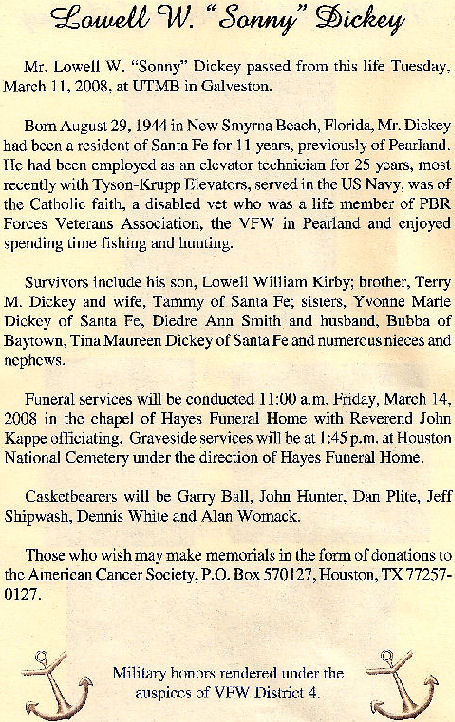
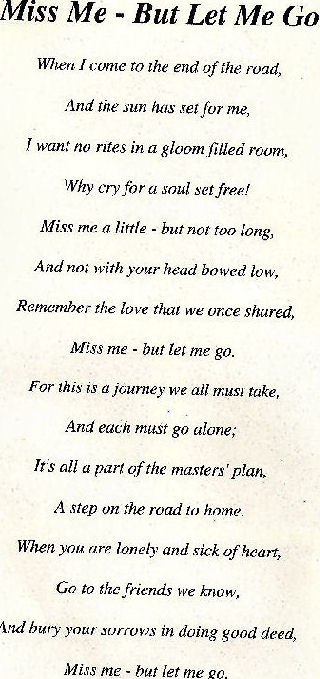
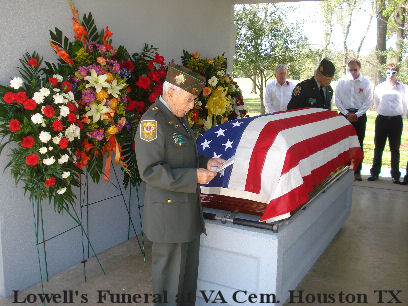
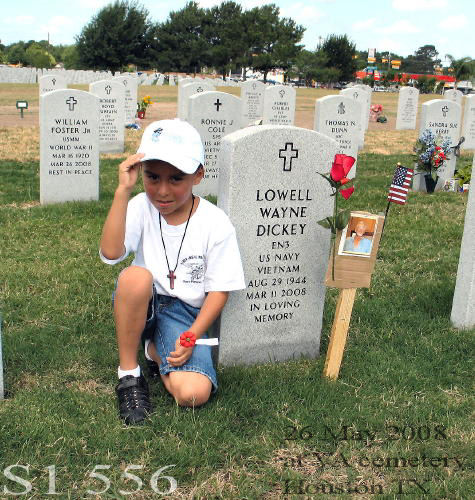
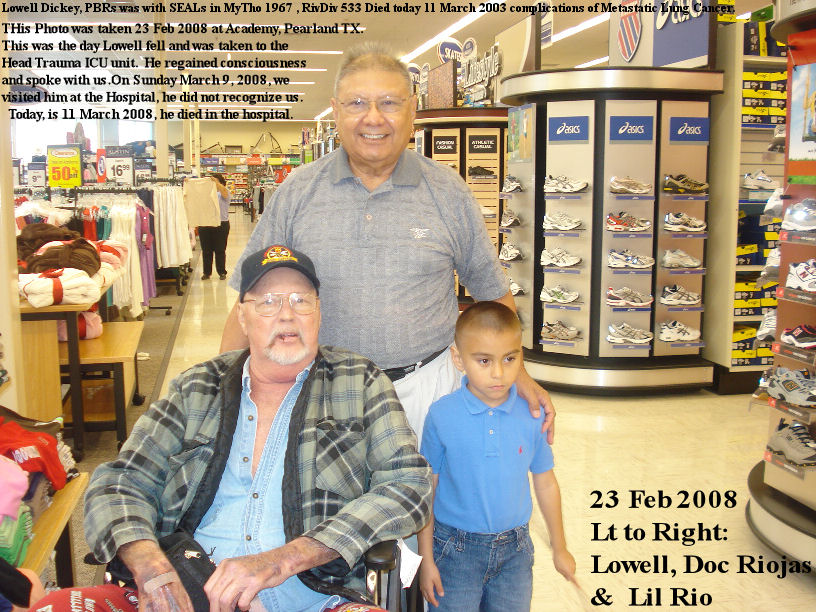
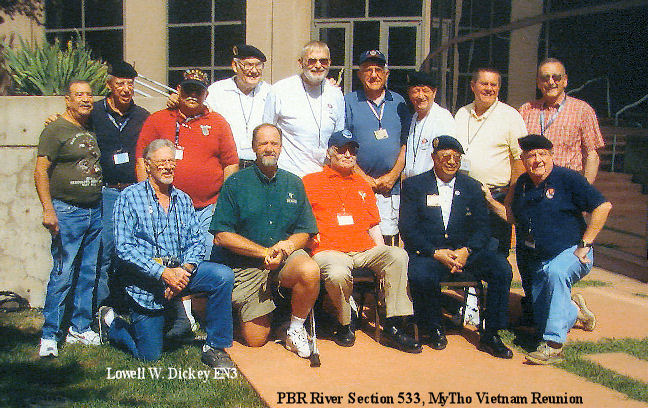
2006 Gamewardens Reunion in Denver: Front Row (L-R): Lowell Dickey, Glen Slay, Bill Goldman, Ken Delfino, Walt Fanton Back Row (L-R): Al Ocanas, Bill Wood, Gary Bay, Jerry Sapp, Dave Ajax, Steve Watson, Harlan McPherson, Duane Pulliam, Jon Inskeep
| From: Ken Delfino To: Doc Riojas Cc: Albert Ocanas Sent: Saturday, January 31, 2009 Subject: 2006 photo Hi Doc, I just visited your website and saw the photo from the 2006 Gamewardens Reunion in Denver. If you need names for the photo, here they are and Pancho can verify: Front Row (L-R): Lowell Dickey, Glen Slay, Bill Goldman, Ken Delfino, Walt Fanton Back Row (L-R): Al Ocanas, Bill Wood, Gary Bay, Jerry Sapp, Dave Ajax, Steve Watson, Harlan McPherson, Duane Pulliam, Jon Inskeep For some reason, RivDiv 533 has had the highest % of attendees at the reunions with RivDiv 591 coming in a close 2nd. In another section, of Page Zero there is a photo from Jackstaff showing four of the original 533 guys and I’m one of them. The caption below the article incorrectly states that we commissioned the original PBRs…not true. |
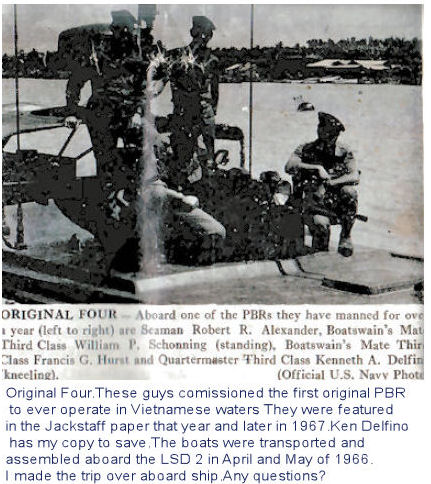
We commissioned the original 533 boats. Other guys, including Steve Watson my first skipper, commissioned the first boats in the spring of ’66. I did not arrive until September and hit the rivers in October.
My first sighting of “Mighty Mo” was on the lower Long Tau on my second patrol…you guys had a VC tied spread-eagle to the ramp!!! Ken P.S. Recognize that buoy behind my right ear…off the docks at My Tho?
This email was cleaned by emailStripper, available for free from http://www.papercut.biz/emailStripper.htm
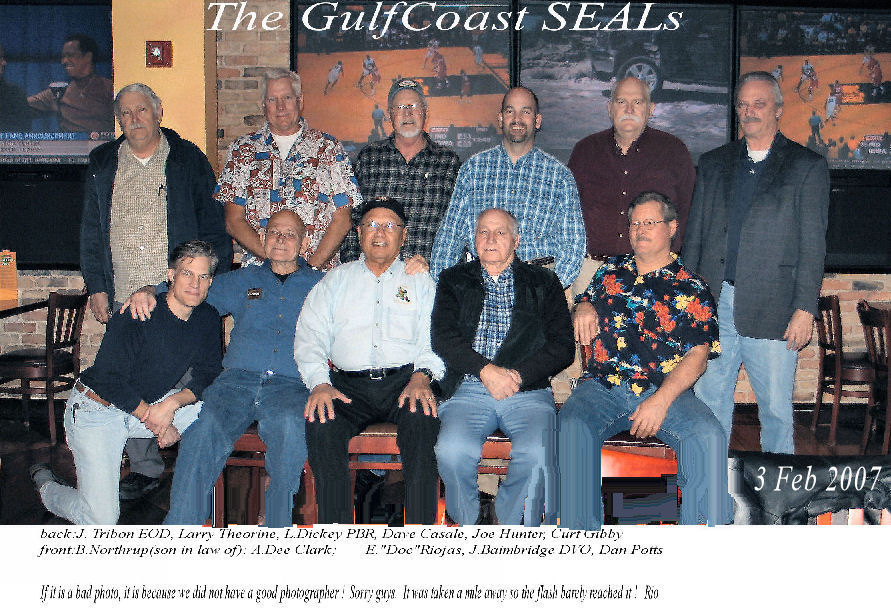
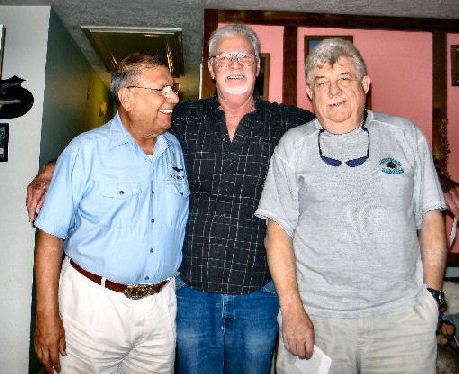
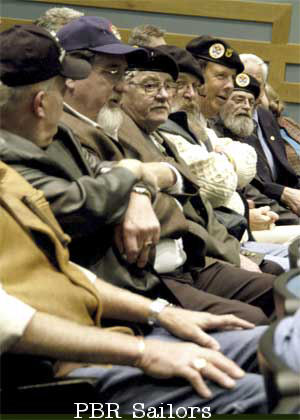
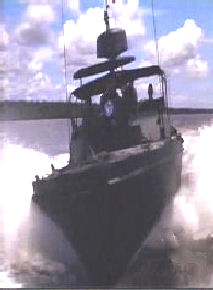
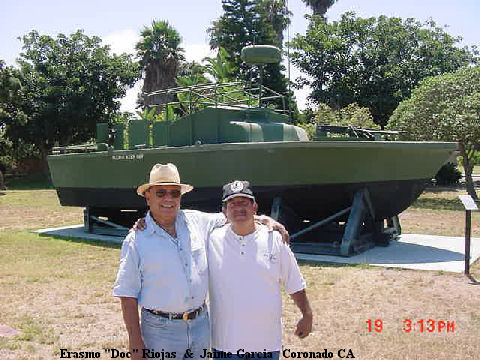
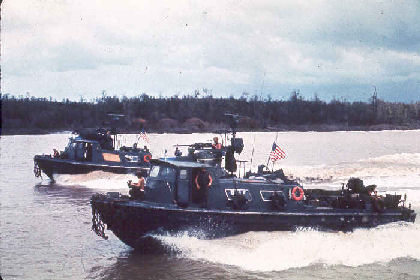
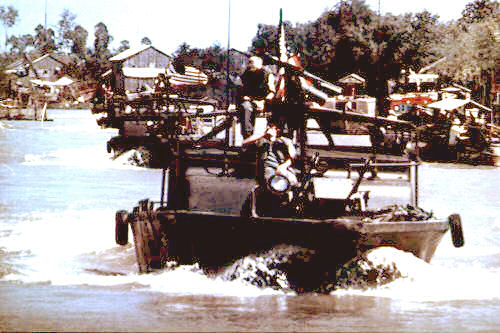
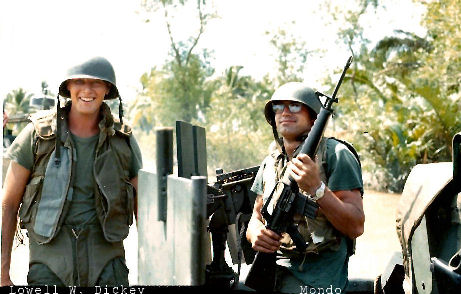
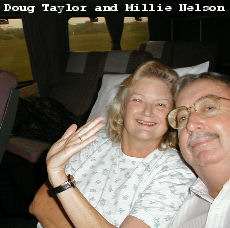
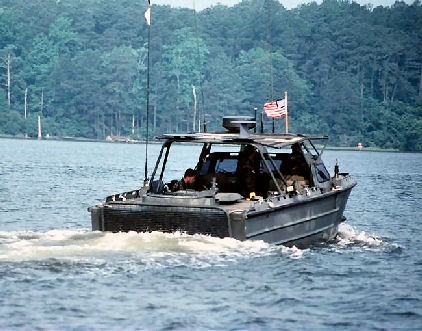
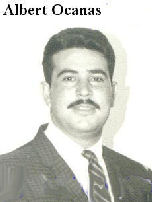
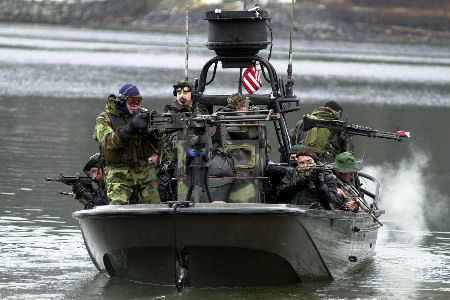
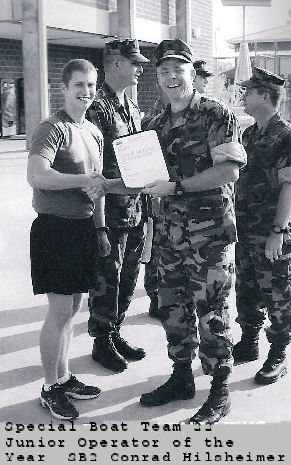
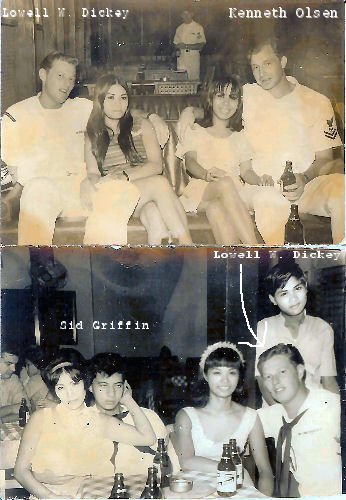
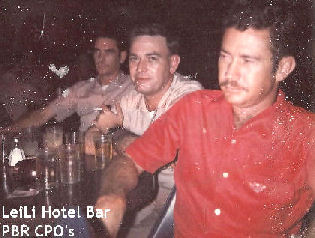
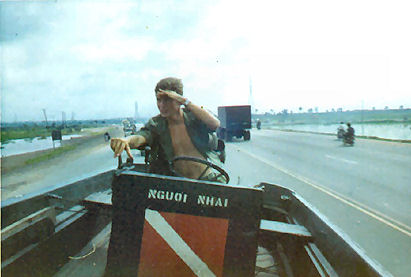
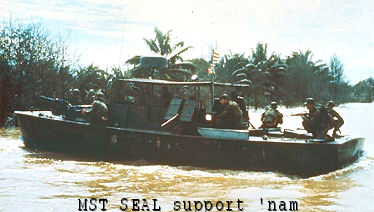
YOUR SITE IS BEYOND UNBELEIVEABLE. I LOVE IT. CLICK ON PAGE 0 1ST PIC ELLIOT WILLIAMS MEDAL OF HONOR GO DOWN TO RAG HEADS @ SEAL RE-UNION 2006. MY SEA DADDY RON POGUE, JOE VITALE, MY X-WIFE LORRIE, GLEN WILLIAMS, PAUL CAGLE. PIC JUST ABOVE IN LOVING MEMORY OF LOWELL W. DICKEY.
ALLOT OF MEMORIES DOC
JOE VITALE AKA: CRAZY JOE
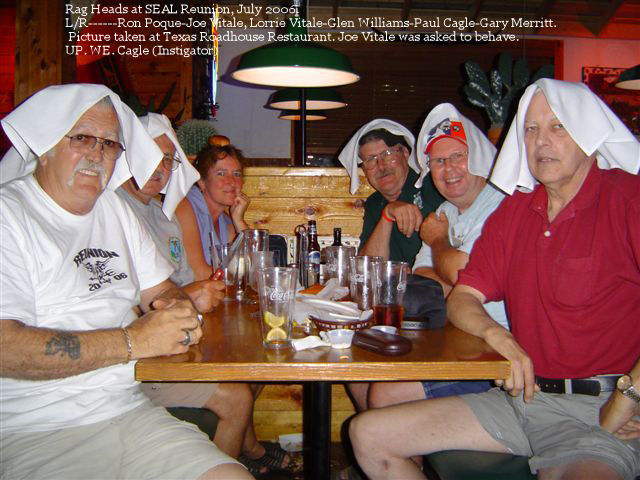
“RagHeads” at SEAL Reunion , July 2001. Lt-Rt: Ron Poque, Joe Vitale (He was asked to behave. ( Up.WE. Cagle was Instigator) , Glen williams, Paul Cagle, Gary Merritt,Picture was taken at the Texas Roadhouse Restaurant
All the guy except Ron Poque were in River Section/Division 532. Master Chief(RET) Ron Poque was a SEAL with 30 years of service. All of us belong to the UDT/SEAL Association by sponsored membership.
532 was stationed in My Tho several times from 1965 until 1969. There were breaks in those times when 532 was on the USS Hunterdon County on the Ham Luong River and special ops. to Quih Nhon.
Former GMG3 Joseph B. Vitale has a case before the Board of Corrections and Medals for the CMOH. It has been in progress for six years and has finally reached the final stages. This came from SecNav in August.
The CMOH incident happened on 02APR68 near the Mo Cay Canal and involved PBR-139 rescuing Mike Wacasey and Joe Vitale who were trapped inland by a large force of enemy troops.
Paul Cagle
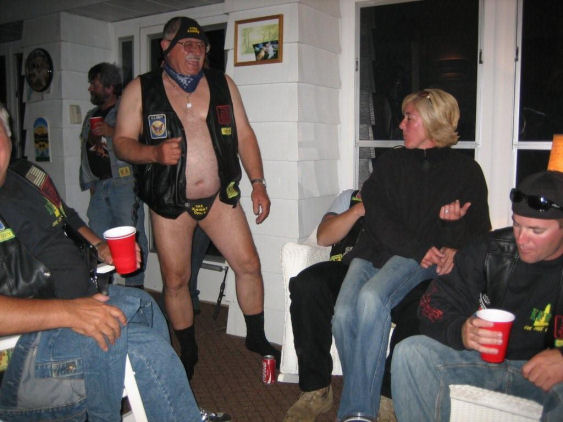
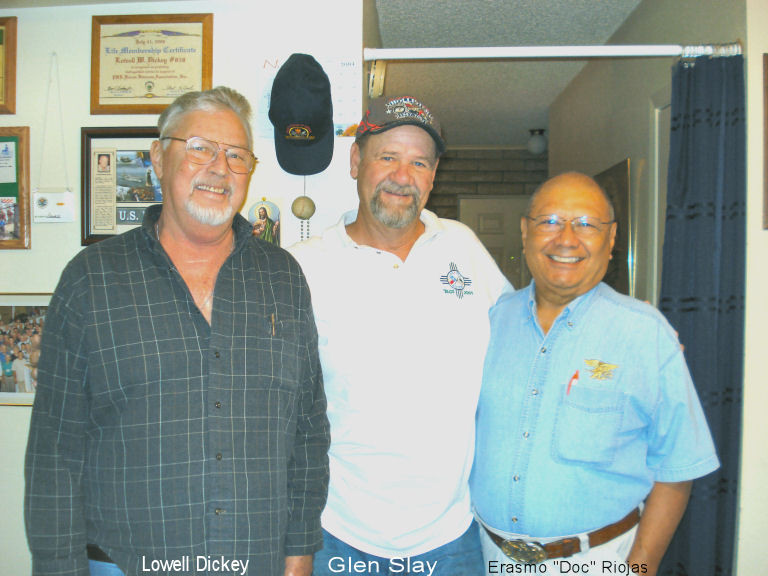
LINKS
Robert”Bob”Stoner,GMCM(SW)(Ret.)
https://www.warboats.org/
Built to deliver and support Navy SEAL operations, this high-tech carbon-fiber craft is both beautiful and deadly smart. Get a closer look at the military’s floating feat of engineering with this exclusive image gallery.
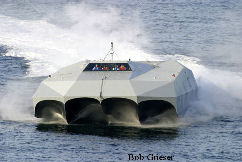
Craft and Boats
MST-2 ‘Nam
T.F. 116 Website & photo gallery
Patrol, River Boat (PBR)
photos of the MK II
Years of Combat, 1965-1968 River Patrol
Gamewardens of Vietnam
Mobile Riverine Force Assoc. in Vietnam
Wannabe SLAYERS
Many PBR’s Photos on FreeRepublic.com
Patrol Torpedo Fast (PTF)“The Nasty Class”
War Boats
Patriot Guard Riders
The River War in Vietnam
.
An Imposing Riverine Environment
Operation JACKSTAY
DECKHOUSE V
Seventh Fleet Naval Gunfire Support
Naval Advisory Group and the Vietnamese
RAGs
The Coastal Surveillance Force
The River Patrol Force
Mobile Riverine Force
Operation SEA LORDS
Gerry Flowers (USMC Recon):
MOORE’s MARAUDERS
Albert “Pancho” Ocanas
Vietnam Photo Album

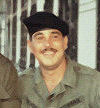
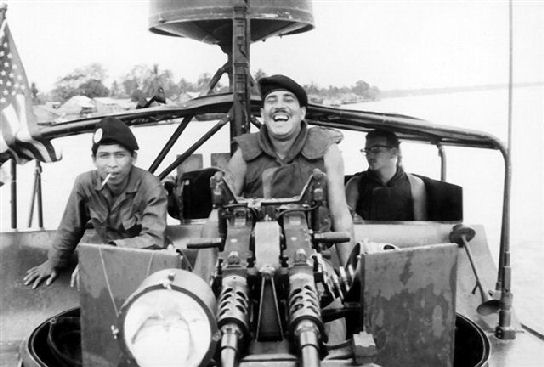
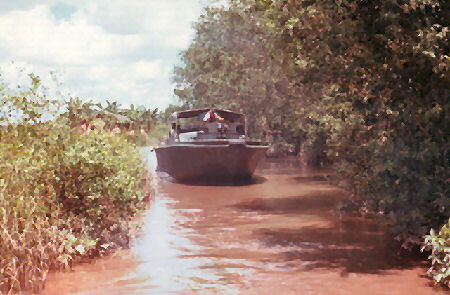
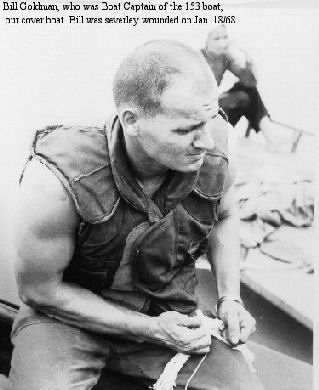
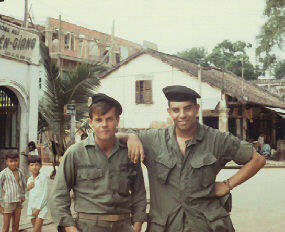
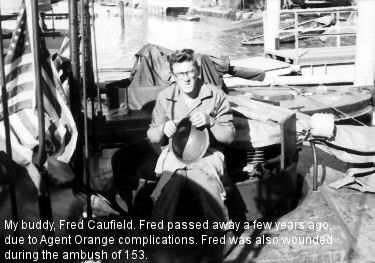
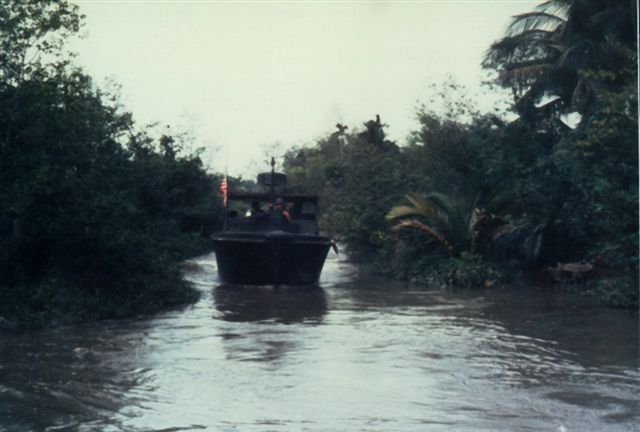
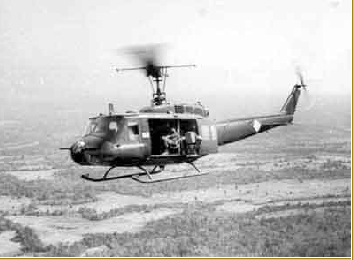
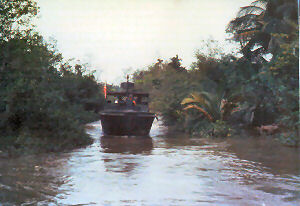
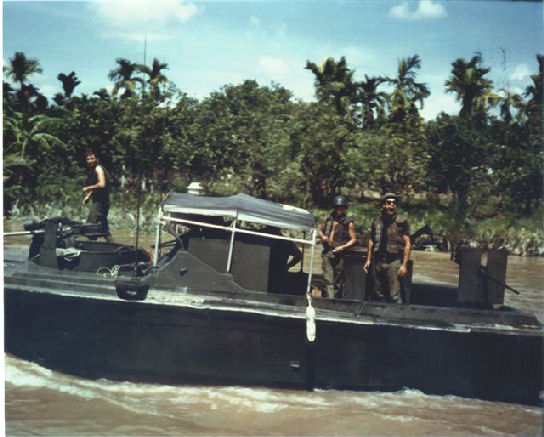
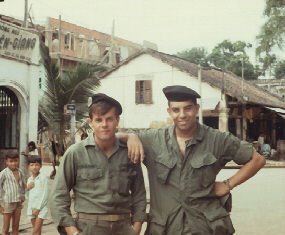
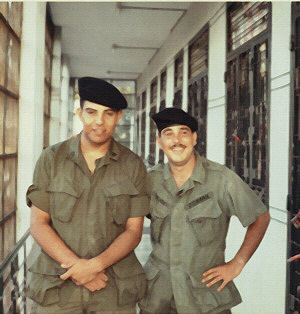
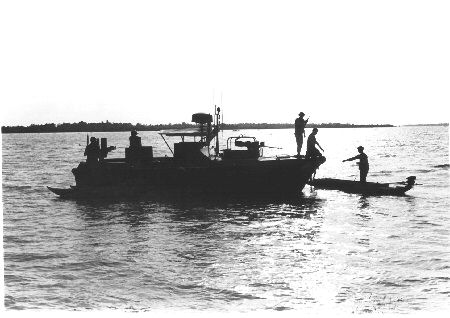
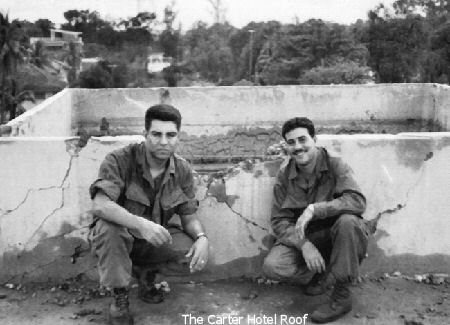
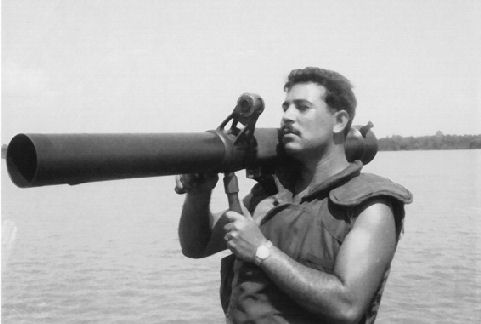
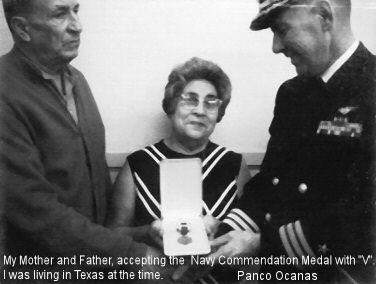
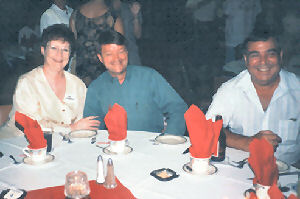
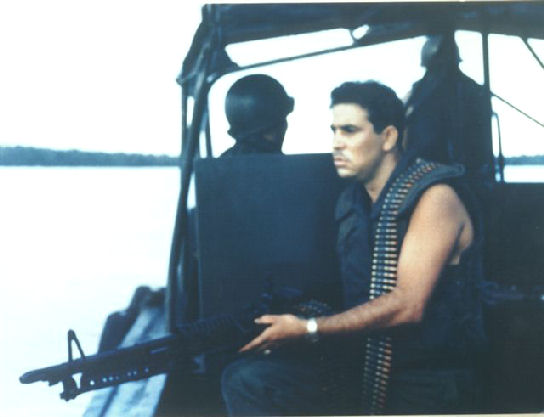
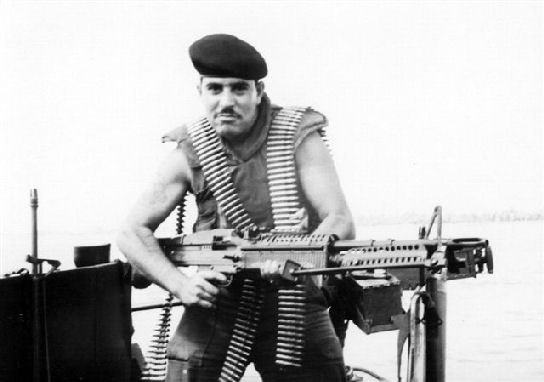
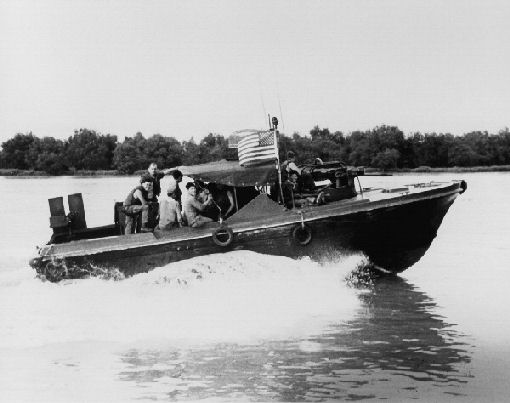
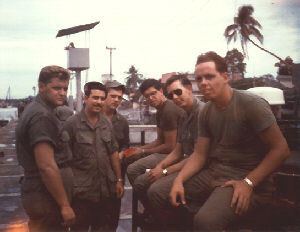
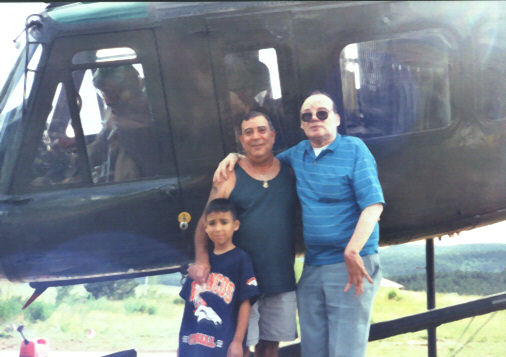
🙂 Howdy there, Doc ~
Hope you and your kin are both warm and well. It’s a bit chilly up here but we be grateful unto God for His providence and protection.
Hey mate, as a means of honoring those to whom it is due – it ain’t me that put that WarBoats.Org web-site together: one of the hard-working fellows that really has done a bang-up job is Jim Gray, a retired Gunner’s Mate (Master Chief). Jim is an extraordinary special boat-guy and if you and I were to be inserted/extracted, we’d want this fellow in our crew, ya’ dig? I first met him in ’83 and am pleased to be back in contact with him. I’m humbled at the remembrance of all them boat drivers who’ve helped you and I throughout the decades, and of their own blood, sweat and tears shed.
Doc, you’ve got great photographs on the SEAL 2 web-site. It brings back some memories, that’s for sure. Thank you kindly for your hard work, sir. I salute you.
Hope to communicate with ya’ again soon. Adios mi amigo…
Billy Hoffmann JesusChristKING [at] centurytel.net
Alleluia: for the Lord God omnipotent reigneth.
Aleluya: porque reino el Senor nuestro Dios Todo-poderoso.
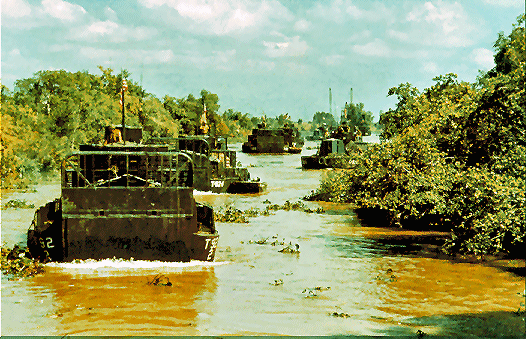
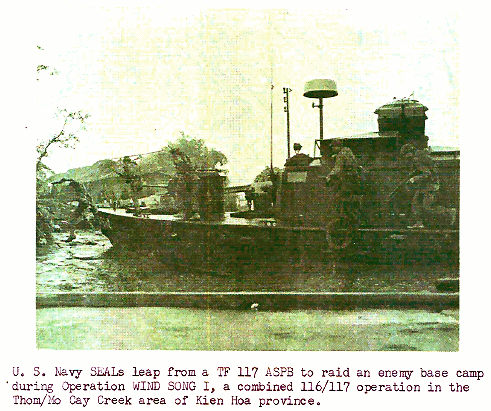
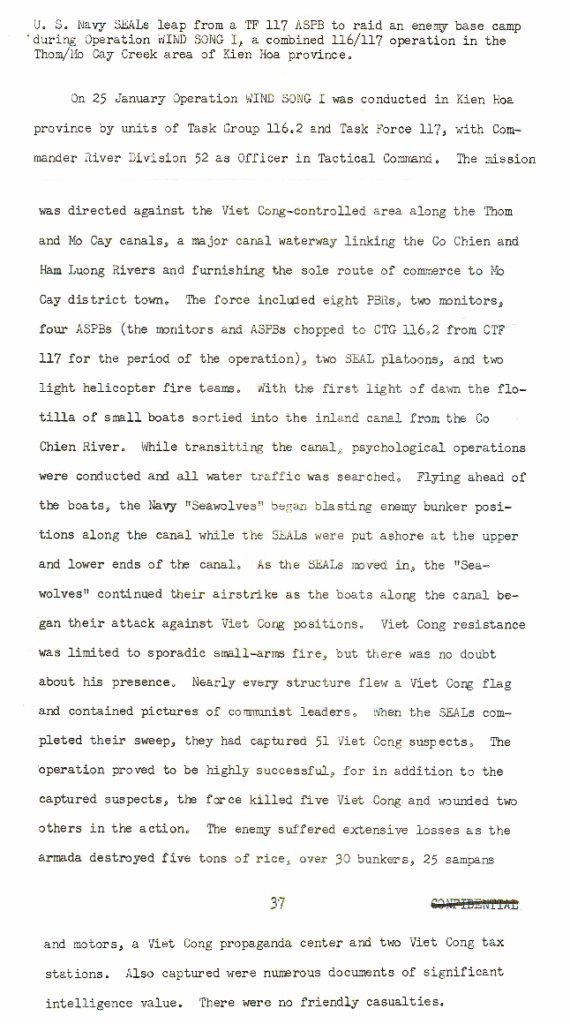
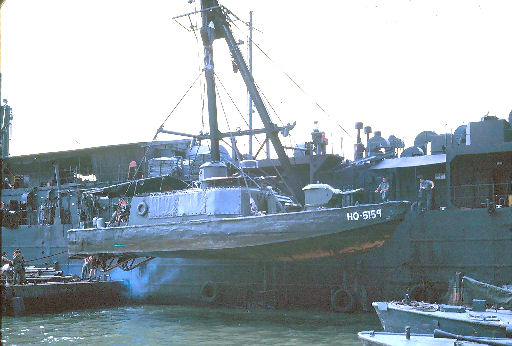
From: Rick Shepherd
To: Doc Riojas
Cc: John Rapp ; Blas Mojica ; Bill Moreo
Sent: May 19, 2008
Subject: the photo will follow
Doc,
Blas Mojica, Bill Moreo and I operated with with MST supporting ST1 from September 67 to March 68 in Nha Be. John Rapp was in Ben Tuey 66 – 67 and supported with ST2.
Bill Moreo and I were with a group that went to Grafton, Illinois to Grafton Boat Company during the summer of 1968 advising during the development of the LSSC. We then flew into Ben Tuey Air Force base with the first to put into service on a Air Force transport plane and I remained there with Blas Mojica supporting ST2 till early 1969 in Ben Tuey.
Crazy Toothman was with us, Robinson with his dog Silver, Steve Dunthorn, Dilly, Sonny Boyd and the late Roberto Ramos who was KIA during that time. In 68 Rapp went to My Tho and supporting ST2 Seals Lt. Murphy, Johnny Jaunzems, Rudy Boesch, Pete Jarard, Piere Burch, Curtis Ashton.
Moreo operated with Rapp in My Tho during this time frame and Rapp stays in touch with JJ and has been to several ST2 reunions.
Rick
John R. Rapp Remembers Vietnam
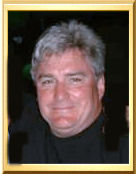
May 22, 2008
Doc Riojas,
I am still going through my records looking for exact personnel names, dates of deployment, detachment assignments, etc.
There is one fella from MST-2 out of Binh Thuy who was wounded on my LCPL during a new platoon and MST Det. three boat day-light shake down trip to Cu Lao Ton Din Island (Free fire designated) ,,, his name is Tom Petty. He later was my gunner on the LSSC up in My Tho on another deployment until he was reassigned.
Add EN2 Glenn R. Loutsenhizer (Skip) to your MST roster for 1968 My Tho Det…
From: John R. Rapp
To: ‘Doc Riojas’
Sent: Thursday, May 22, 2008
Subject: More info
Good morning Doc!
The organizational structure as I remember it, and this references the West coast organization (((East coast had a mirrored command structure using TWO as the numeric identifier Two,,, NSWG Two, SEAL Team Two, Underwater Demolition Teams 21, and 22, Boat Support Unit Two, Beach Jumper Unit Two, the East coast had no components deployed to the war zone)))
The West Coast — Our command structure was as follows –
Naval Operations Support Group Pacific, was changed around 1966 or 1967 to
Naval Special Warfare Group One
Components of that command were as follows…
SEAL Team One
Underwater Demolition Teams 11, 12, and 13
Boat Support Unit One
Beach Jumper Unit One
Deployed components were –
SEAL Team One (combat deployed platoons, as well as individual members assigned to NSA / NAD / SOG Saigon, and NSA / NAD / SOG Danang and others)
Underwater Demolition Team (combat deployed Platoons)
Boat Support Unit One – detachments were deployed as Mobile Support Teams of which there were three. MST-1 (Danang – PTF’s / Nasty Boats), MST-2 (SEAL Support Teams – Mekong Delta), MST-3 (Coastal / Harbor / Inshore Security and Patrol)
Beach Jumper Unit One (Psychological Warfare operations throughout the theater)
Specifics on operations and operational tempos are hard to document. Elapsed time and aging memory make for poor components,,, generally mixing dates, times, actions, and spatial locations into a stew!!! Ha…
With that said, the dance cards for all in country special operations should be in someone’s possession. In those records you would find the specifics on most operations – who, what, where, when, results, etc…
FYI – I was told that when the BSU was decommissioned most of the records of the unit including personnel assigned to the unit were discarded into a trash dumpster and one of the authors of the Warboats.com website recovered as many as he could manage. SO – you might be able to survey those records if the report is true.
The initial MST deployment to the Mekong Delta Vietnam by BSU as MST was in 1966 to support SEAL operations. Later on this combination of SEAL and MST components became known as the PACKAGE. SEAL’s and Mobile Support Teams / SEAL Support Teams. This deployment was known as Project Zulu.
Project Zulu / Detachment Alpha and the detachment Commanding Officer was Lt. Sam Braly (My Tho) and the XO was Lt. S. L. Baumgard (Binh Thuy). A few of the original enlisted members were Dennis Thompson, Buck Owens, and others I can’t remember at this time. (although I was a GMG, I relieved Buck Owens (BM) in Binh Thuy around the second month of his deployment so he could return to Coronado to take care of a family emergency)…
Prior to deployment from Coronado, the handpicked BSU crews redesigned several vessels for use in support of SEAL operations, fitted out the vessels, developed operational tactics, and trained for deployment. Deployments of SEAL One and SEAL Two platoons as well as MST-2 teams located to Nhe Be (ST-1), My Tho (ST-2), Vinh Long (ST-1), and Binh Thuy (ST-2)…
Among the redesigned vessels were the LCPL, LCM-6, and an off the shelf boat known as the STAB. Although the LCM-6 and LCPL were used for insertions and extractions the primary vessel for that duty was the STAB, in addition to the Boston Whaler, and IBS…
MST boats were also known as the HSSC (Heavy SEAL Support Craft), MSSC (Medium SEAL Support CRAFT), LSSC (Light SEAL Support Craft)… These vessels changed or were replaced over the years of deployment as newer designed boats were added to the MST components.
Firepower changed as well. The original Project Zulu LCPL assigned to Binh Thuy had four .50 caliber BMG. One on the bow, one port and starboard, and aft. In addition we carried a 60MM handheld mortar of which I took over for fire support missions, one BAR (relic), AR-15 / M-16’s, 9MM Model 39 S&W, M-79 (my favorite), one Honeywell hand cranked belt fed 40MM grenade launcher later replaced with an M-60, LAW 67MM Anti-Tank Rockets, and on occasion a 57MM Recoilless Rifle.
FYI – I was in Binh Thuy operating with the original Project Zulu platoon and MST for a few months until it was relieved by another platoon and new MST detachment of which I stayed and operated until the next normal rotation. In 1968 I returned for another deployment to My Tho…
The Binh Thuy platoon members were from SEAL Team Two
Lt. Trani (KIA)
Lt. Bishop
Lt. Murphy
“Clem” Clemson
Sam Fornier
John Guntis Jaunzems (JJ)
Bill MaCarthy
Jack Shultz
McQueen
Terry Sullivan
Peter Irish
Joe Silva
Fred Toothman
Fred McCutcheon (spelling)
Frank Thornton
Pete Girard
Doc Richard “Leg” Martin
Doc “Shorty”Long
Tocci
David Sutherland (WIA) on my boat during insertion
Jerry Stamey (WIA) on my boat during insertion
Others….
MST / Boat guys (a few of which were replacements for Project Zulu crew)
Lt. Thompson (spelling)
John R. Rapp (Leading Gunners Mate / MSSC – LSSC driver)
Blas Mojica (GMG, drove everything)
Kaufman (EN)
Nelson Haney (ET)
Dallas Clark (EN)
Jim Bunning (MSSC – LSSC driver)
Hendricks (my gunner on the Boston Whaler that was ambushed on insertion in the Long Toan District of Vinh Binh Province (coastal op) on September 8, 1967…
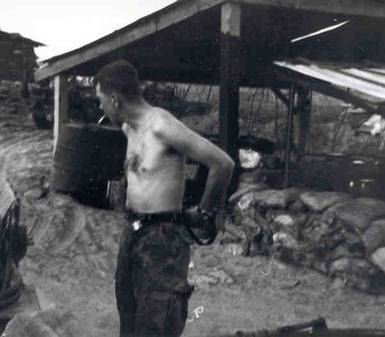
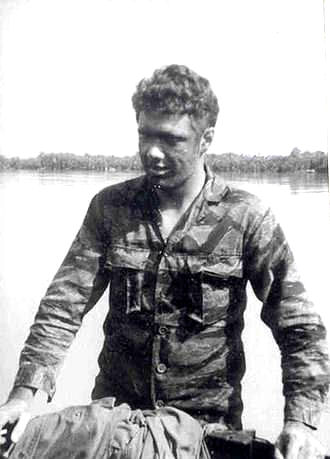
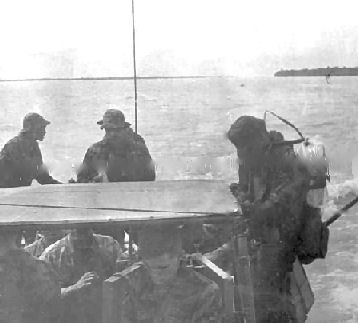
John Rapp (boat driver) – GMG, 1967, Binh Thuy / Bassac River , STAB not seen executed the Dung Island extraction
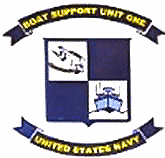
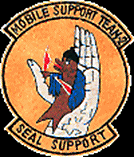
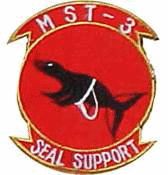
MSSC (LCPL) – MST-2 / SEAL Support Team – 2 / Detachment Alpha
“In addition to the information Rick and Bill has sent you I will forward to you updated information on BSU-1, MST-2, SEAL Support Team-2 in support of UDT / SEAL operations in Vietnam.”
Subject: Bill Moreo, Rick Shepard, Blas Mojica
Rick and I just returned home from Lubbock, Texas after spending the last four or five days visiting Mo. As you are probably aware Mo is quite ill with cancer as a result of his exposure to Beta and Gamma waves during one of the nuclear air burst test he participated in during his time in the Marine Corp,,, before his three years in the Army,,, and his remainder of time in the Navy until his retirement from the Navy…
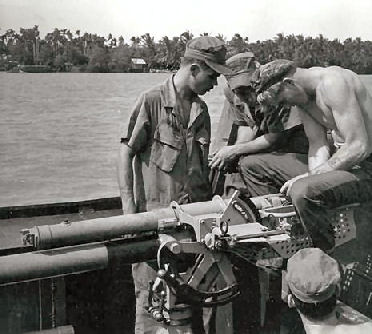
John Rapp instructing 81MM. Mortar firing procedures to Nelson Haney, Ed Blazinza, Michael Cali on the My Tho HSSC / Black Sheep 1 – 1968
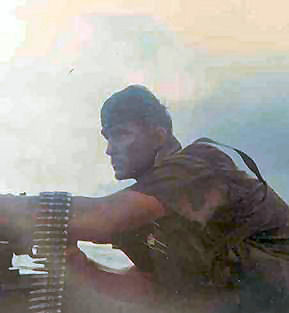
John Rapp on M-60 LSSC out of My Tho 1968 / Bill Moreo and I switched between driver and shooter… Brim rotted off the boonie hat!
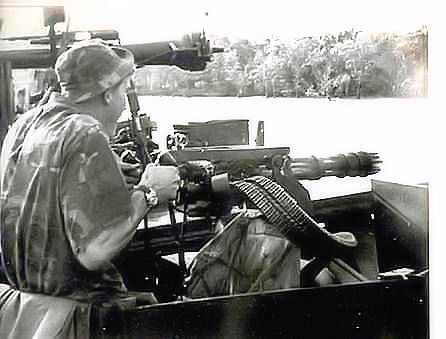
John Rapp on the GE / Mini-Gin 7.62 HSSC / Blacksheep 1 out of My Tho 1968 – early 1969
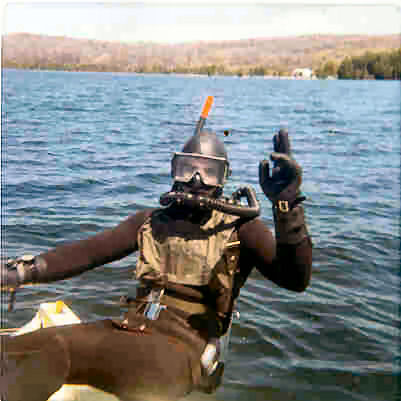
John Rapp – 1970 or so Crystal lake dive / North-West lower peninsula of Michigan, early open circuit SCUBA stuff (USD 71.2 CF 2270 psi., Aqualung regulator or Voight Trieste with built in reserve lever… I must have weighed 180 then vs. 230 lbs. now…
I found my deployment record for –
Project Zulu / Det-A / MST-2 / Bien Thuy…
May 18, 1967 November 22, 1967
Remember, I was sent over early to relieve Buck Owens BM for family reasons (an original Project Zulu member). I finished his time and then stayed with the next group…
Correction: Add Jack Schultz to the SEAL Two platoon in My tho! Hell it’s only been 39.5 years…
One more correctionI added Skip Lautsenhizer to the MST My Tho crew list…
Here is the corrected info on the My Tho deployment.
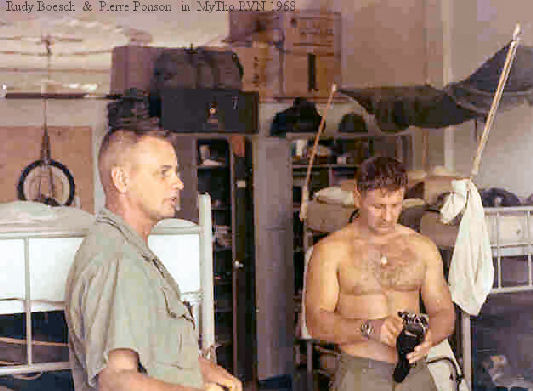
Rudy and Pierre were roommates at the time. Their Picture taken by me when was in My Tho in 1968 – 1969. I roomed on the other side of their wall and down at the end.
These guys were fom SEAL Team Two but I forget the platoon number.
They were a great bunch of guys…
SEAL Two Platoon
OinC was Lt. Bill Bishop
XO was Lt. Murphy
John Juanzems
Bill McCarthy
Fred Keener
Toothman
Terry Sullivan
Peter Irish
Jack Schultz
Curtis Ashton
Pierre Birch
Rudy Boesch
Peter Girard
Ed McQueen
Doc Martin
Others team guys need to be remembered if anyone out there can help…
Tour of DutyMy Tho, RVN. MST-2 August 8, 1968 to January 28, 1969
Thomas Gorla, Lt. (OinC of our MST-2 Detachment in My Tho)
(Tom Gorla –great officer, played football at Notre Dame)
John R. Rapp GMG-2 (senior Gunners Mate, LSSC driver insertion / extraction, fire support)
Bill Moreo En-2 (LSSC driver, insertion / extraction, fire support)
Ed Blazina
Michael Calli
Nelson Haney
Frank Beard EN-1 (HSSC coxswain)
Kaufman EN-2
There may have been a few other boat guys – but I can’t remember.
Doc, please accept this corrected information to replace the original information I forwarded for posting on your web-site… The original text and photographs can be found on Page Zero of your web page just above and below the photo of Rudy and Pierre and the other photo of John Jaunzems and John Rapp. Thank you,
John R. Rapp
Corrected Information (names, dates, location) as know to be accurate at this time…
Subject: 1967 Operation with SEAL Platoons out of Binh Thuy and other areas, with staging aboard an LST anchored as a forward operating base for a PBR detachment out at the mouth of the Bassac River…
Note: This information was compiled with the help of Commander Bill Langley ‘SEAL Team Two’ who was a member of the Binh Thuy platoon.
I was awarded a Navy Commendation Medal with the V device for a night mission where ‘Bobby Stamey’ and ‘Joe Silva’ were WIA on my unarmed Whaler during a coastal insertion… I had the throttle shot out of my hand leaving only a stub to control the RPM, steering control was lost resulting in Hendricks (my gunner) wrapping his arms around the motor and turning it at my direction in order to continue the insertion.
Under the direction of Lt. Bill Bishop (SEAL Team Two) we did not abort the insertion but continued forward through the surf lines to the beach! Joe Silva (serious arm would) did not egress with us but inserted with the squad. I then extracted with Bobby Stamey and Hendricks back out to sea. We stopped at the MSSC (LCPL) to provide the severely wounded Stamey emergency medical attention, and then continued transport to the HSSC (LCM-6) where I remember Doc Shorty Long taking over Stameys’ treatment and medical evacuation… Unbelievable night and day!!!
John R. Rapp
From: Karen & Pete Peterson
To: Doc Riojas Sent: Friday, June 06, 2008
Subject: Navy Artist with us in ‘nam
Rio: great job collecting and filing all of those photos. I recall a navy artist spent some time with our platoon in My tho taking photos for his use back home in doing oil painting for the navy artist collection. i do not recall his names. seems he did a painting of Kelley and the 106 RR. he rode the baot and took his photos there. Do you recall him. might be a source of photos for you.
Pete in Spicewood TX
This email was cleaned by emailStripper, available for free from http://www.papercut.biz/emailStripper.htm
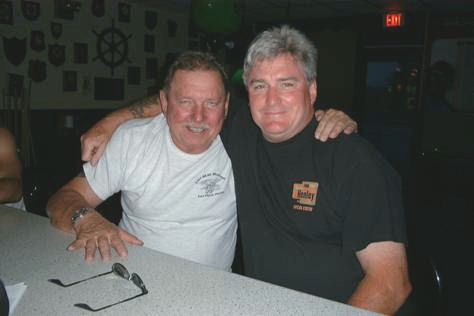
From: Eugenio Crescini
To: Doc Riojas
Sent: Tuesday, July 15, 2008
SEAL Team 2, Detach Alfa, 5th Plt, RSSZ,Vietnam:
I put the these men thru BASIC(East Coast 1964-1965):
Lt Jukoski, Ltjg Norris, Ashton, R. Davis, Waters, Peck, Ebner & Baron (5 Plt at Nam)
LT. M. Jukoski LTjg T. Norris
DMC E. Crescini
BT1 D. Zmuda
BM1 A. Ashton
HM1 R. Lashomb
BM2 R. Davis
EN2 E. Ebner
BM2 F. Waters
DK2 K. Peck
STG2 J. Glasscock
ABM2 P. Hood
AM3 T. Baron
GMG3 M. Pierson
LDNN Long
From: John R. Rapp
To: Doc Riojas
Sent: Thursday, July 17, 2008
Subject: Check this out Doc…
I was awarded a Comm.Medal for the op where Jerry Stamey and Davey Sutherland were WIA on my Whaler during a coastal insertion… I had the throttle shot out of my hand, steering control was lost resulting in Hendricks wrapping his arms around the motor and turning it at my direction in order to continue the insertion. At the guidance of Lt. Bill Bishop we did not abort the insertion but continued on! Davey Sutherland (serious arm would) did not egress with us but inserted with the squad. I then egressed with Jerry Stamey and Hendricks (my gunner) out to sea to get Stamey medical attention. We stopped at the MSSC (LCPL) to provide the severely wounded Stamey emergency medical attention, and then continued transport to the HSSC (LCM-6) where I remember Doc Shorty Long taking over Stameys’ treatment and medical evacuation… Unbelievable night and day!!!
Upon return to the LST at the mouth of the Bassac River, the Whaler was removed from the water and placed on deck. A close inspection of the damaged Whaler showed a whole bunch of bullet holes,,, most notably the little console where my knee, arm, and hand were located and directly in front of me where Stamey and Sutherland were positioned. How the rounds managed to miss me and everyone else aboard was the miracle of the day!
John Rapp
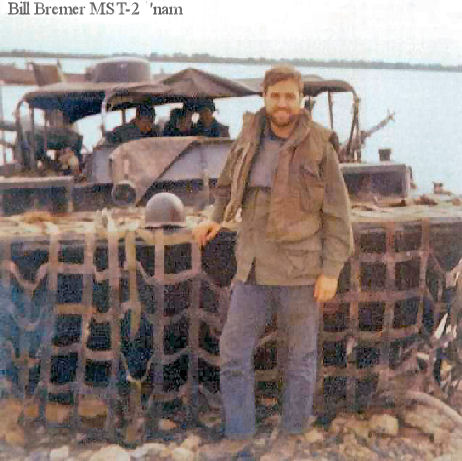
From: “Robert Stoner” <rstonercrd21 [at] msn.com>
To: “Dan Withers” <dwithers [at] rodaxwireless.com>;
“Erasmo “Doc” Riojas” <docrio45 [at] gmail.com>
Subject: BM2 Gary Hunt: MST-2, Det. Alpha and ST-1 X-Ray Platoon
Date: Monday, June 16, 2008
Dan and Doc,
Jim Gray sent this to me for the MST and SEAL sites.
*********** BM2 Gary Hunt MST-2 Det Alpha–Ben Tre Viet Nam
MST-2 Det Alpha operated out of Ben Tre and had one MSSC, one LSSC, and a whaler and supported SEAL Team ONE X-ray Platoon.
On 28 Feb 1971 we received a call nobody wants to get, a emergency call for assistance. Our own LSSC out on a mission was ambushed and received a direct hit by a B-40 rocket.
On Board the LSSC: MST-2, QM1 Cronk – had one ear drum shattered MST-2, EN2 McClaren – lost his right leg
SEALs on board: CWO2 Jones – okay EN1 Doyle – okay RM3 Majors – both eardrums shattered and shrapnel wounds in right leg PT2 Walsh – both eardrums shattered SN Barns – lost right leg SN McCarthy – had right hip blown apart and shrapnel wounds in right arm Cheiu Hoi Tran van Pham – both legs blown off; died aboard the boat
The LSSC had made it to the 10th Regt Fire Support Base and the wounded Medevaced. We towed the LSSC back to Ben Tre. It was awful to clean up all that blood in the boat. It had taken the hit right in crew compartment and almost went all the way through the opposite side.
Other SEALs I remember: LT Collins – X-ray’s OIC, who was later killed EM1 De Croce – badly wounded RM2 Baker BM3 Trigg FN Clayton
There were others as X-Ray took casualties and replacements came in. The LDNN assigned to the platoon was named Thang.
This email was cleaned by emailStripper, available for free from http://www.papercut.biz/emailStripper.htm
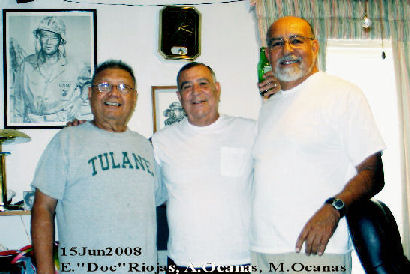
From: wshark79 [at] aol.com
To: docrio45 [at] gmail.com
Sent: Sunday, June 22, 2008
Subject: U.A.V.’s
DOC Riojas,
I”M BILL MOREO ENCM(SW) USN RET. BSU-1 MST-1,2,3 SEAL TEAM-1,2 .
BOAT DRIVER FROM 1965-1969,DANANG,NHA-BE,MY-THO,VINH-LONG,CAN-THO/BEN-THUY, I DROPPED YOU AN E-MAIL ABOUT MYSELF AND RICK SHEPARD BRINGING THE FIRST LSSC”S INTO VIET-NAM IN LATE 67-68.
YOU MAY KNOW SOME OF MY RUNNING MATES JOHN RAPP,BLAS MOJICA.
I”M GLAD YOU ENJOYED THE UAV”S,WE SURE COULD HAVE USED THEM IN COUNTRY,BUT WE DID HAVE THE BIRD DOGS. SHARK 79″R WAS MY RADIO CALL SIGN IN NHA-BE.
TO ALL, MY HEARTFELT THANKS ,TO ALL WHO WORKED ON GETTING A MEMBERSHIP FOR MY LONGTIME FRIEND AND BROTHER IN ARMS IN THE UDT/SEAL ORGANIZATION,
I SERVED ALONG SIDE “BLAS” IN DANANG-65-66,NHA-BE-66-67,CAN-THO/BEN-THUY 67-68,ME-THO 68-69, HE WAS, AN IS ONE OF THE TOP OPERATORS DURING THE VIET-NAM WAR HE HAD MY BACK AND MANY OF THE SEAL TEAM PLATOONS WE SERVED,ONCE AGAIN THANK YOU FOR HONORING HIM, THROUGH HIM YOU HONOR ALL OF US THAT SERVED IN THE MST/SEAL COMMUNITY IN COUNTRY.
BEST REGARDS,
BILL MOREO ENCM(SW) USN.RET
Webmaster’s NOTE: Thank you Master Chief, Welcome back to the world and Thank you Very Much for your service. Erasmo “Doc” Riojas, HMC USN Ret. “Semper Fi” and “Hoo-Yah!”
Morning Folks,
Doc Riojas, if you want to publish it on your website, here’s a humorous trailer for you of my next book. IF not, enjoy the read…. Later, Carl
Howdy men, I hope everybody is impatiently awaiting the arrival of the third installment in The Indomitable Patriot series. The book takes us back to 1943 and the submarine USS Great White (SS-299), commanded by LCDR Marcus Spencer. You will recall the Great White and Captain Spencer from the first book, FERTIG, along with Evelyn “Pinky” Pinkert and LCDR (detailed OSS) David Meyers from both FERTIG and book two, DEAN. The Great White is at Mare Island for overhaul and installation of some OSS communications gear. After attending meetings at OSS headquarters, Spencer, Meyers and Pinky drive the the OSS training academy, the former Congressional County Club. All right, here’s a short, humorous trailer from book three….
The meeting continued for a couple more hours before breaking. Meyers, Captain Spencer and Pinky drove to the Country Club to spend the night with Pinky in the guesthouse. The following morning they would fly to Fort Monmouth in Pinky’s Staggerwing Beechcraft.
~~~ ~~~
“It never fails to amaze me, whenever I come down here,” Meyers said as they parked in front of the administration building. “I’ll never forget the first two weeks of the academy when Pinky shared a bunk in a dormitory with twenty-three other men.”
“That’s all right, Mister Meyers,” Pinky said, ice in her voice. “We can save that story for another time!”
“Now my interest is peaked,” Spencer replied.
“Later, sir,” Pinky replied as she deeply blushed. “Only after a martini will I be able to tell that story.”
“My humble command,” Pinky said when Meyers and Spencer stopped and stared at the barbed-wire encased Quonset huts. “Come inside administration for a moment and I will introduce you to Colonel Godfrey, our administrator. Not even the Colonel has clearance to enter the barbed wire. After meeting the Colonel, David and I will give you a tour of the facility.”
As they drove around the complex, David and Pinky explained the training program for OSS Special Agents. They were parked at one of the five-hundred yard ranges when Spencer asked, “You went through all this firearms training, Pinky?”
“Captain Spencer,” Meyers answered, “Pinky is a distinguished master with a rifle. She can outshoot me.”
Spencer glanced at Pinky. “My COB, or Chief Of the Boat on the Great White is a thin, wiry fellow. Almost soft-spoken, but get under his skin or fail to obey a command, he instantly becomes a grizzly bear. I suspect, ma’am, the two of you are not that different.”
Pinky started up and then abruptly stopped their Jeep. “You see that man out there, Captain, the one leading that squad. He will be going to Tinian with you. His name is Carlos Hathcock, Senior. He can outshoot all of our firearms instructors. He can hit bull’s eyes at a thousand yards with an iron-sighted rifle.”
Spencer slowly shook his head as Pinky started up again. “Such young men we produce, to go in harm’s way,” he muttered under his breath.
~~~ ~~~
Captain Spencer, David and I ate in the cadet’s mess. The food service was very good for cafeteria-style service. Afterward, we adjourned to the recreation room where I fixed martinis for the three of us. David brought up the subject of the academy again… to my great embarrassment.
“You delight in forcing me to tell that story, don’t you, Mister Meyers,” Pinky said as she broke out in laughter.
“Marcus (Spencer had told them to dispense with the Captain Spencer routine), my family owns this place, the former Congressional Country Club. I lived in the guesthouse when they leased it to the OSS for the duration of the war, under the condition I continue residing in the guesthouse. My uncles didn’t want me moving back to Chicago where I would be too close to them. The OSS hired me, and I applied for special agent training. David and I were in the first academy class.”
“For the first two weeks of physical, as well as stress training, everybody lived in open barracks. If you survived that period, you moved into individual rooms for the remainder of the training. Their theory, the enemy would neither discriminate nor go easy on a female, so they lumped everybody together.”
“Sunday afternoon, the day before the training officially began; I’m arranging my uniforms and gear in my locker… in an open bay with twenty-three other guys.”
Marcus began to chuckle and then laugh aloud. “Excuse me, Pinky, I’m picturing you bunking in the crew quarters on a sub and being with eighty men who have not bathed in a week or two. It gets pretty foul at times on a boat!”
“We are all tending to our gear while our drill instructor marches up and down the aisle, screaming ‘The enemy intends to kill you, pretty women as quickly as big, tough men,’ and all that.”
“And then Gunny stops at my bunk. I come to attention. The rim of his Smokey Bear hat a fraction of an inch from my forehead. ‘Pinkert, you get one privilege,’ he screams… spittle landing all over my face. ‘There is one stall in the head with a curtain. That stall is yours alone. In exchange for that privilege, you shall not use the men’s urinal. Do you understand that?’”
“Sir, yes sir,” I screamed in Gunny’s face, biting my tongue to keep from laughing. Then Gunny screams, “Men, you will report immediately if you catch Pinkert using your urinal. Do you understand that?”
“A chorus of ‘Sir, yes sir,’ rang throughout the barracks. By now I’m about to explode with laughter.”
“It got worse when Gunny yelled at us about one shower for everybody,” David interrupted. “I’ll save Pinky further embarrassment and leave that to your imagination.”
“Pinky, water is in such short supply on a sub that bathing usually amounts to a gallon of water, once a week if you’re lucky,” Marcus replied. “There is an officer’s head on board, but it’s usually crammed full of supplies for most of a patrol. Everybody uses one head in the after torpedo room. That, too, becomes pretty foul after weeks at sea.”
Carl McLelland
THE INDOMITABLE PATRIOT Fertig, The Guerrilla General
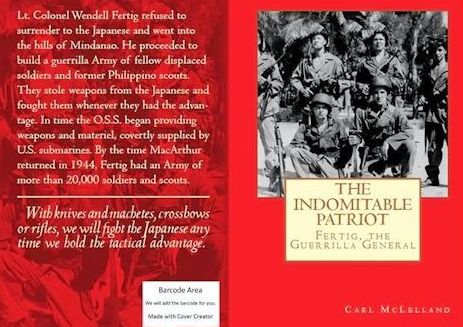
One of our guys, although he had the misfortune of going Army instead of Navy, has become a writer in
his old age. His first few books were about the paranormal… he likes to chase ghosts in his spare time. But his latest
endeavor; Wow! He has started a new series of books he calls Behind the Lines. His first book, recently completed and
published is titled “THE INDOMITABLE PATRIOT: Fertig, the Guerrilla General.” It’s a historically correct novel about Wendell Fertig in the Philippines in World War II. Here’s what the book looks like.
Cover Final :
May, 1942. General Wainwright has just surrendered the Philippines. Wendell Fertig, a Corps of Engineers Lieutenant Colonel, refuses to comply and flees into the mountains of Mindanao. Fertig is soon
joined by dozens of former Philippino Army scouts who encourage him to form a guerrilla Army. Over the next few months Fertig is joined by several other displaced American soldiers, one of whom builds a small, makeshift transmitter and establishes contact with the Navy.
General MacArthur denounces Fertig, going on record claiming it’s impossible for a guerrilla movement in the Philippines to succeed. The O.S.S. decide to take a chance and covertly supplies Fertig by submarine. Once he receives the tools to wage war, his achievements become legendary. By the time MacArthur returns to the Philippines in 1944 he is met on the beach at Leyte by a force of over twenty thousand of Fertig’s guerrilla Army.
This fictional accounting is based upon the actual military records and reports of one man’s impossible achievements against overwhelming odds; against an enemy who outnumbered him a hundred to one. Wendell Fertig, a civil engineer and untrained amateur in the ways of war, defied the predictions of the experts and brought the Japanese Army to its knees. Enjoy this first installment in the new Behind The Lines series of combat thrillers based upon historical records.
.
The book is available from Amazon in either print or Kindle versions, or by special order from almost any book retailer.
(He’s not Tom Clancy yet. They don’t stock his books but they can order them). These links will take you to the Amazon listings. If you look at the Kindle listing there is a Look Inside feature that lets you read through the first chapter.
Print:
http://www.amazon.com/Indomitable-Patriot-Fertig-Guerrilla-General/dp/
1512025623/ref=sr_1_1?ie=UTF8&qid=1431972445&sr=8-1&keywords=the+indomitable+patriot
Kindle:
http://www.amazon.com/Indomitable-
Patriot-Fertig-Guerrilla-General-ebook/dp/B00XUSX4RU/ref=sr_1_1?s=digital-text&ie=UTF8&qid=1432050603&sr=
1-1&keywords=the+indomitable+patriot
About the Author Carl’s professional career began as an Army and then FAA air traffic controller. He advanced from a small radar van in the Central Highlands of Vietnam to the TRACON in one of our nation’s busiest airports. He also became a commercial pilot and flight instructor, retiring after thirty-nine years of flying. By 1986 he was experiencing severe burnout. He put himself through the police academy, resigned from the FAA and became a deputy Sheriff in Reno, Nevada. He retired after a distinguished career on the street. Not only the cop on the beat, Carl became a renowned traffic accident reconstructionist on his departments Major Accident Investigation Team, as well as a highly acclaimed crime scene investigator. Throughout his life Carl has been a student of the paranormal and often experienced the effects of the supernatural in his personal life. In 2012 he became involved in the saga of the haunted Allen House in Monticello, Arkansas and its resident spirit, Ladell Allen Bonner. The result of dozens upon dozens of paranormal interactions with Ladell led Carl to write his first book about Ladell’s life and death. Writing that first book sparked a latent avocation in his life: writing. Carl has always been a connoisseur of military history, and that interest began a new direction for his writing. This latest book is the story of Wendell Fertig, and the beginning of a thrilling new series, ‘Behind The Lines.’ While the stories are fictionalized, they are all based upon factual military history. Join in with Carl and enjoy his books as you gain an interesting new insight in what war is all about.
The following is typical of the reviews I’m receiving on the book:
Just finished your book and you get 4.0 marks from this old Navy Seal. Really enjoyed and it adds to my hobby of WWII.
Spent 22 years of my 34 in and out of the PI. Have traveled every island and was trained a marksman by RJ when we were
stationed at Team 2 during Vietnam. Still a very good friend I keep in contact with. Going to recommend it to my friends,
at least the ones that can read.
THE INDOMITABLE PATRIOT Fertig, The Guerrilla General
Doc Riojas Comment: Once i started reading this book, i have find myself hard to putting it down! because of my very old age (84 yr old eyes and at the end of being able to correct my vision) I find that the way the paragraphs are other important text are spaced to be extremly easy to read.
Having retired from the Navy and traveled to that part of the orient reminds me of my days as a guerrilla combatant as part of the Navy SPecial Warfare serving as a Navy SEAL in the Jungles of Vietnam.
The author is equally as good a military writter as Tom Clancy. This story may possibly be material for a great movie similar to the the movie produced about the POW rescue in WWII by Filipino Guerilla fighters and the U.S. Army Rangers. “The Great Raid”
Do not wait to buy it tomorrow, order it today ! It was recommended to me by CDR R.D. Thomas (recommended for the Medal of Honor by the US Army, but our politically correct US Navy downgraded it to a Navy Cross. SHame on them !
